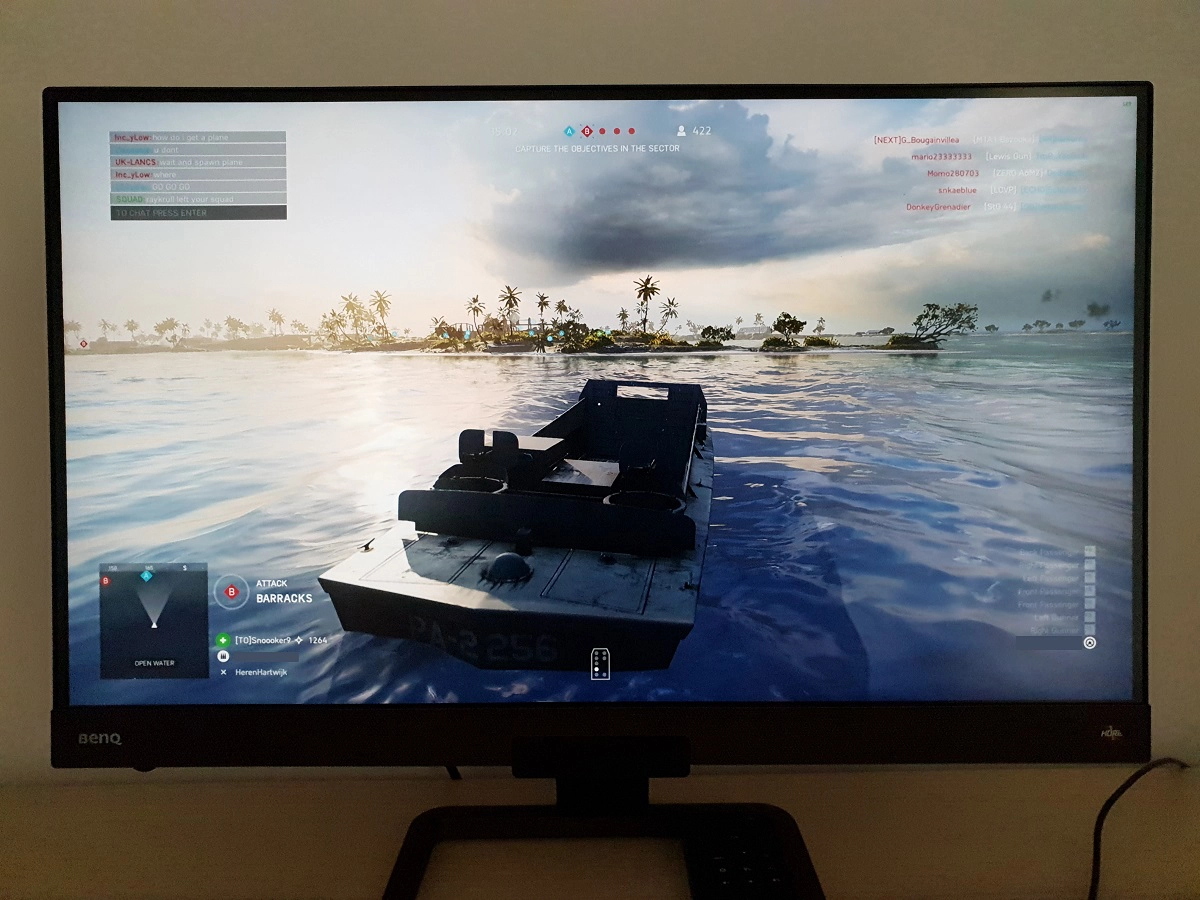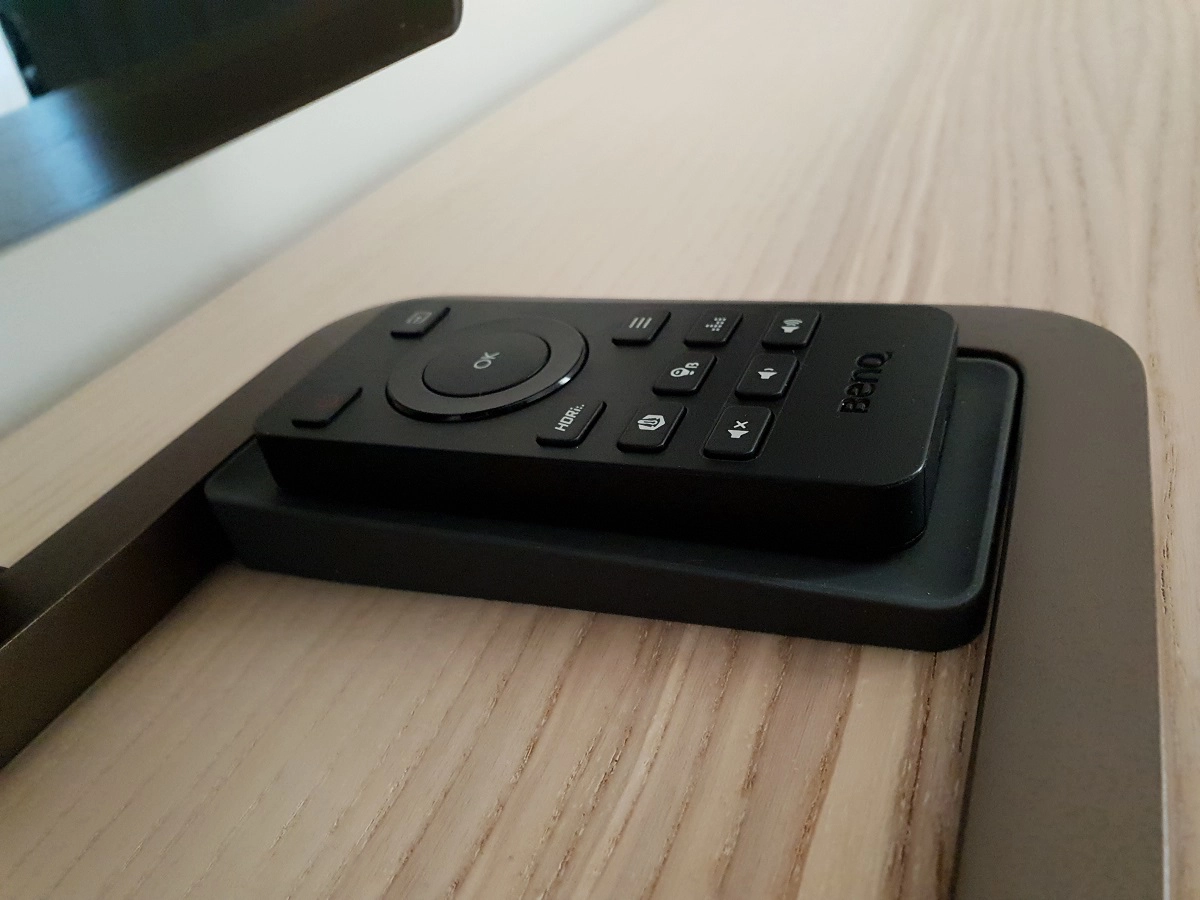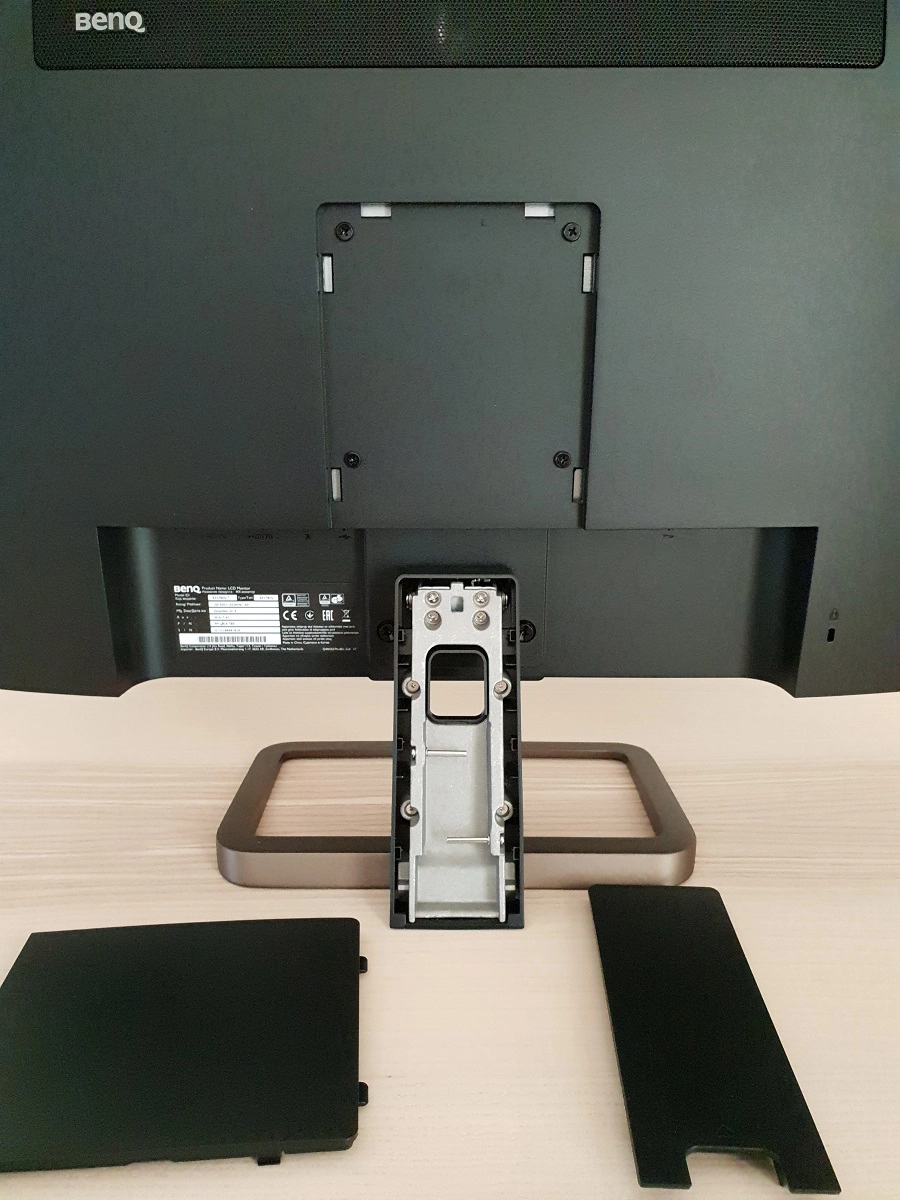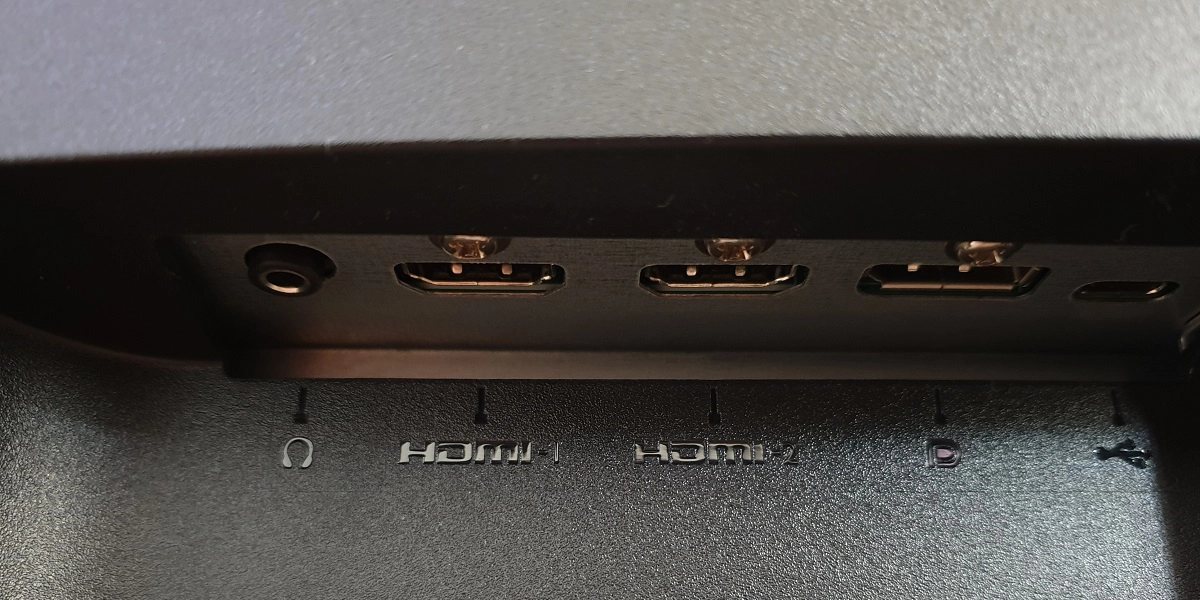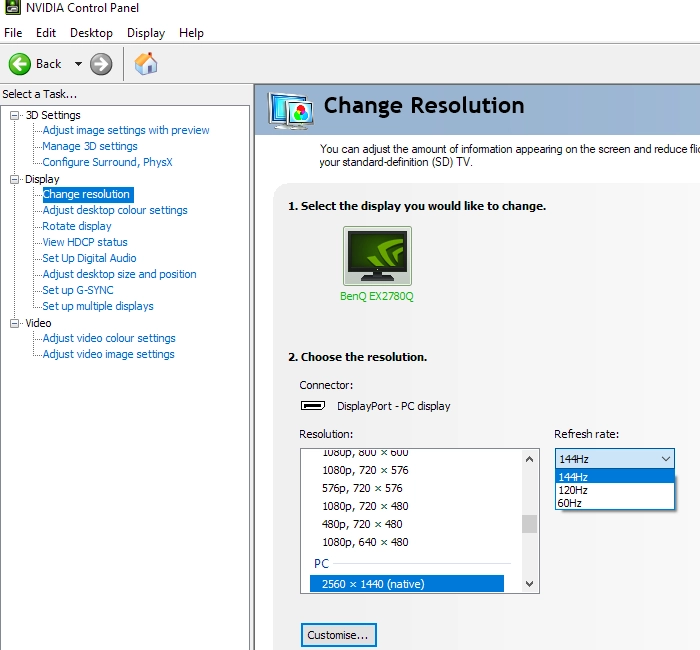Author: Adam Simmons
Date published: March 19th 2020
Table of Contents
Introduction
For some users, the combination of high refresh rate and 2560 x 1440 (WQHD) resolution is very attractive. Throw in an IPS-type panel for improved colour quality, and this can prove very tempting indeed. The BenQ EX2780Q hits this sweet spot, combining them with support for Adaptive-Sync, VESA DisplayHDR 400 and some BenQ-specific features. We take this monitor for a spin, testing out many of its intriguing features and seeing how it performs in our usual suite of tests.
Specifications
The monitor uses a 27” panel from Innolux with AAS (Azimuthal Anchoring Switch) technology. This is an IPS-type (In-Plane Switching type) panel. A 144Hz refresh rate is supported, alongside 10-bit colour (8-bit + FRC dithering). A 5ms grey to grey response time is specified, but as usual such figures should be approached with caution. Some of the key ‘talking points’ for this monitor have been highlighted in blue below, for your reading convenience.
The monitor has a homely look from the front, with a fairly unusual aesthetic due to the choice of colour for the bottom bezel and stand base. The stand base is bronze-coloured, finished in powder-coated metal. The bottom bezel takes the form of a large plastic speaker grille. Finished in a subtle reddish-brown colour, with a honeycomb mesh texture. The speaker grille is part of the reason for the relatively large size of the bottom bezel – 32mm or 1.26 inches. This excludes the black boxy area which hangs down another 5mm or so centrally. This contains a light sensor that’s used for the ‘B.I.+’ feature plus an IR sensor for the included remote control. These features are explored in the OSD (On Screen Display) video shortly. The top and side bezels are much slimmer, with a dual-stage bezel – ~7.5mm (0.30 inches). The largest element at the front is the screen itself, which features a light matte anti-glare finish as explore shortly. The OSD can be controlled by two distinct methods. There’s a TV-style IR remote control, shown below. This can be placed on a small grippy silicon tray that sits inside the stand base. This tray can be repositioned inside the stand base or simply removed if preferred. Alternatively, some pressable buttons and a joystick are located at the rear of the monitor. Running vertically down the bottom of the right side, as viewed from in front. There’s also a volume control wheel towards the left side, facing downwards. The OSD control systems and menu itself is explored in the video below. From the side the monitor is reasonably svelte – ~20mm (0.79 inches) at thinnest point, with a bit of extra bulk centrally. The included stand offers tilt (5° forwards, 20° backwards) as the only ergonomic flexibility. The bottom of the screen sits ~76mm (2.99 inches) above the desk surface, including the underhang of the central sensor box. Meanwhile, the top of the screen sits ~462mm (18.19 inches) above the desk. The screen sits ~195mm (7.68 inches) back from the frontmost points of the stand base. Matte black plastic dominates at the rear. The included stand attaches towards the bottom and can be unscrewed and removed if you wish. In the centre there is a plastic cover which can be clipped off to reveal 100 x 100mm VESA holes for alternative mounting. A cable-tidy loop can be found at the bottom of the stand neck, beneath a cover that slides upwards for removal. Towards the right side there is a K-Slot, whilst at the left side you can see the OSD controls. The ports face downwards and include; a 3.5mm headphone jack, 2 HDMI 2.0 ports, DP 1.4, USB-C (DP Alt Mode and upstream data) and an AC power input (internal power converter). Towards the top there is a 5W subwoofer, complementing the 2 x 2W speakers integrated into the bottom bezel at the front of the monitor. This ‘treVolo’ 2.1 speaker setup offers quite a full and rich sound with plenty of bass and decent and flexible volume. We wouldn’t say that sound is as crisp or ‘clean’ as some models, such as the mightily impressive 2 x 12W speakers of the ASUS CG32UQ. But compared to most monitor speakers the sound was much more pleasing to the ear. There are various ‘Audio Scenario’ settings so you can adjust things a bit according to your preferences. We found the default ‘Live/POP’ to be the best balanced with some of the others sounding quite hollow and not putting the main bonus of this speaker system (the subwoofer) to good use. The native 2560 x 1440 @144Hz plus HDR functionality is supported via DP 1.4 and HDMI 2.0. Adaptive-Sync is also supported via DP 1.4 and HDMI 2.0, although the latter only supports AMD FreeSync specifically. A power cable and HDMI cable is included as standard. Some additional accessories may be included in some regions and by some retailers; a DP cable, DP to MiniDP cable, USB-C cable and 3.5mm audio cable. The monitor supports a wide range of refresh rates when running in ‘1080p, 1920 x 1080’ (Full HD), including 24Hz, as shown in the first image below. A ‘4k x 2k, 3840 x 2160’ mode is also included, downsampling the ‘4K’ UHD resolution. 60Hz is the maximum refresh rate supported with this downsampling mode, alongside the lower refresh rates listed for the Full HD resolution. This is useful for devices such as some games consoles that don’t support a 2560 x 1440 signal but would accept a 3840 x 2160 signal. The refresh rates supported for the native 2560 x 1440 (WQHD) resolution are 60Hz, 120Hz and 144Hz as shown in the second image. Listed refresh rates are the same via HDMI and DP. The image below is a macro photograph taken on Notepad with ClearType disabled. The letters ‘PCM’ are typed out to help highlight any potential text rendering issues related to unusual subpixel structure, whilst the white space more clearly shows the actual subpixel layout alongside a rough indication of screen surface. This model uses a light matte anti-glare screen surface with a relatively smooth surface texture. Such a surface affords relatively good glare handling, avoiding the sort of distinct reflections you’d see on a glossy or much lighter screen surface. Meanwhile, clarity and vibrancy is better preserved compared to ‘stronger’ matte screen surfaces. When observing lighter shades there was only a light misty graininess rather than a heavy or ‘smeary’ graininess. Most users will either not notice this or find it just fine. This screen surface texture is just slightly less smooth than some competing models (using LG Nano IPS panels, for example) but significantly smoother than competing 27” WQHD VA models. It offers more direct emission of light with lower diffusion, giving it less of a ‘layered’ appearance in comparison. As illustrated above the standard RGB (Red, Green and Blue) stripe subpixel layout is used. This is the default expected by modern operating systems such as Microsoft Windows and Apple MacOS. You needn’t worry about text fringing from non-standard subpixel layouts as a Mac user and don’t need to run ClearType as a Windows user. You may still wish to run through the ClearType wizard and adjust according to preferences, however. The subpixel layout and arrangement is normal and we had no subpixel-related concerns related to sharpness or text clarity on this model. The BenQ EX2780Q offers various ‘Color Mode’ presets; ‘Low Blue Light’, ‘Rec. 709’, ‘Color Weakness’, ‘M-book’, ‘Standard’, ‘Gamer1’, ‘Gamer2’, ‘Gamer3’ and ‘User’. Additional ‘HDR Mode’ presets are included; ‘Game HDRi’, ‘Cinema HDRi’ and ‘Display HDR’. These are the only presets available under HDR, but can also be selected under SDR where they act as ‘HDR emulation’ settings – although we find that to be a very misleading term as you can’t simply ‘emulate HDR’ whilst using an SDR signal. We touch upon these presets in the OSD video and explore some of them elsewhere in the review. For this section we’ll mainly focus on manual adjustments that can be made in the OSD and a small selection of the ‘Color Mode’ presets. The table below includes gamma and white point readings taken using a Datacolor SpyderX Elite colorimeter. General observations made by eye are also included. Our test system uses Windows 10 and an Nvidia GTX 1080 Ti connected using a DP cable. Additional testing was performed with an AMD Radeon RX 580 and using HDMI, although for the purposes of this table that had no impact. No additional monitor drivers or ICC profiles were specifically loaded. The monitor was left to run for over 2 hours before readings were taken or observations made. Aside from our ‘Test Settings’ where various adjustments are made, assume factory defaults are used with the monitor running at 144Hz. Adjusting the refresh rate did not affect the static image quality of readings for this table, however. When viewing the figures in this table, note that for most PC users ‘6500K’ for white point and ‘2.2’ for gamma are good targets to aim for. Individual targets depend on individual uses, tastes and the lighting environment, however.
As an Amazon Associate I earn from qualifying purchases made using the below link. Where possible, you’ll be redirected to your nearest store. Further information on supporting our work.
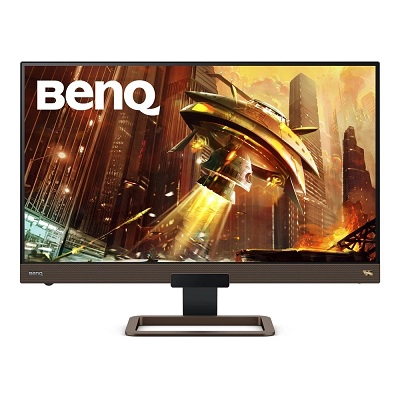
Features and aesthetics
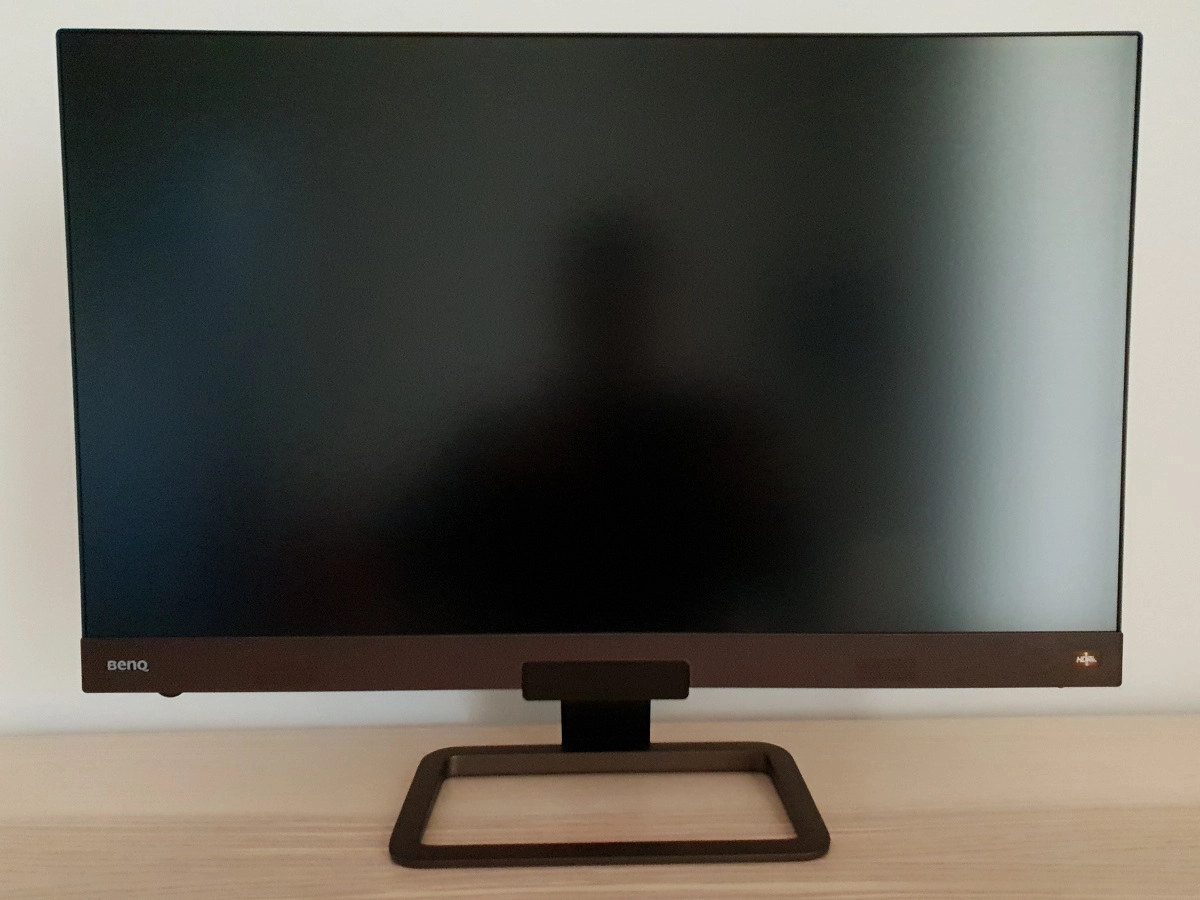
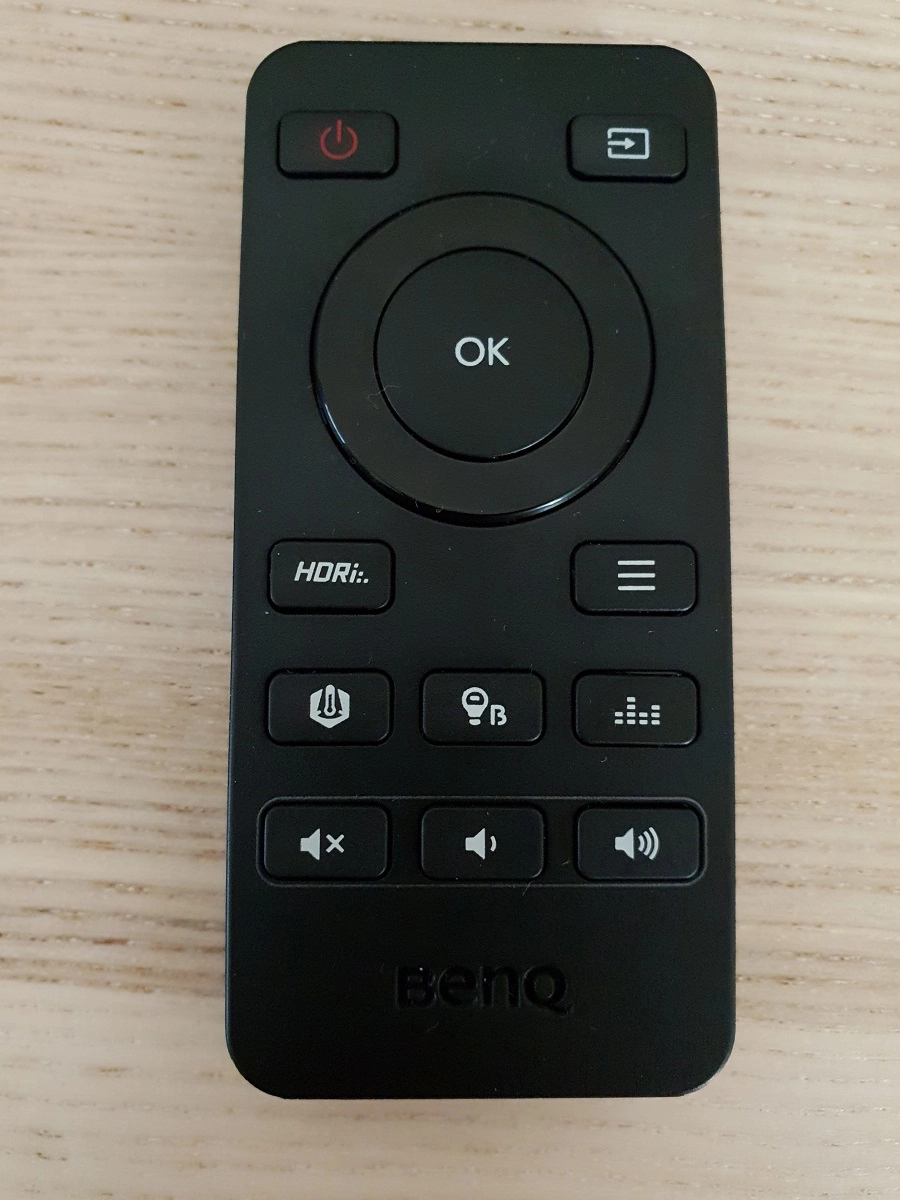
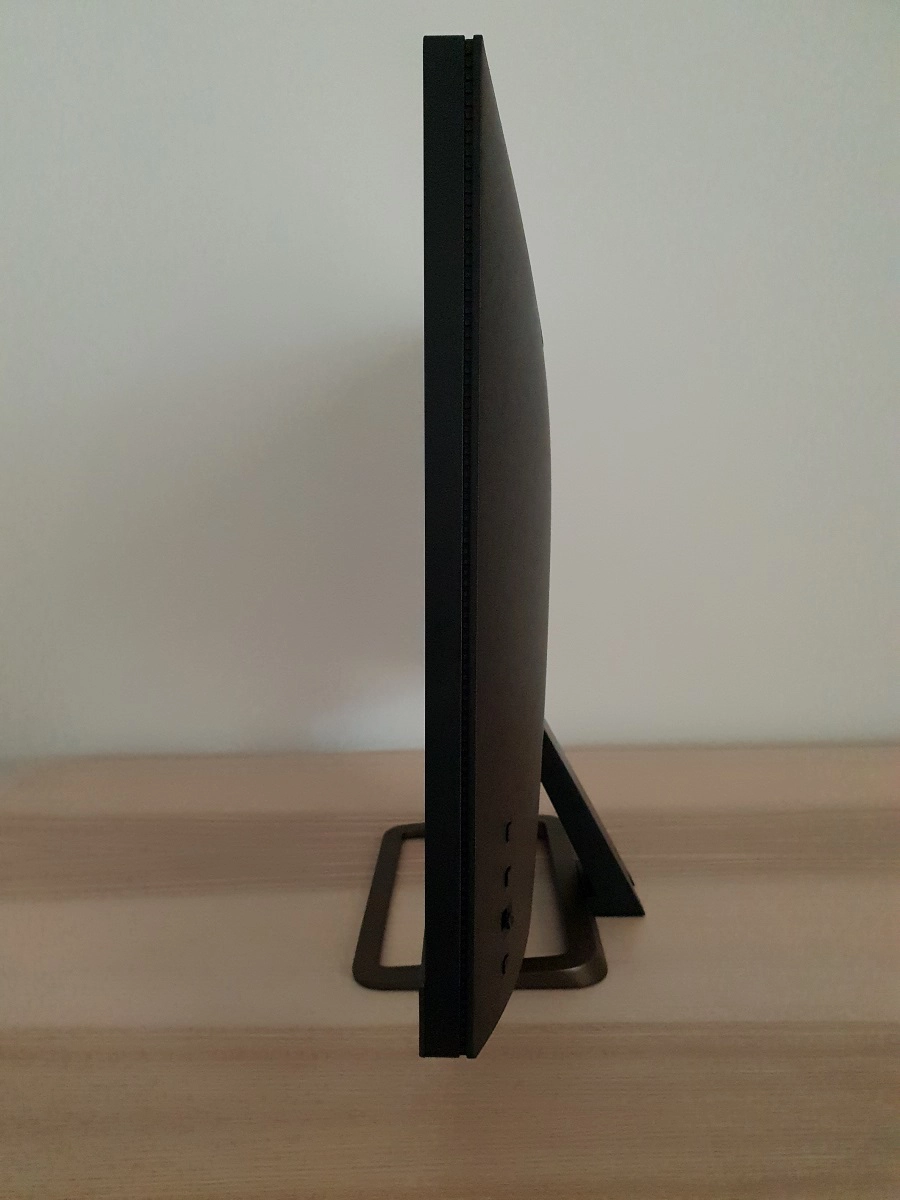
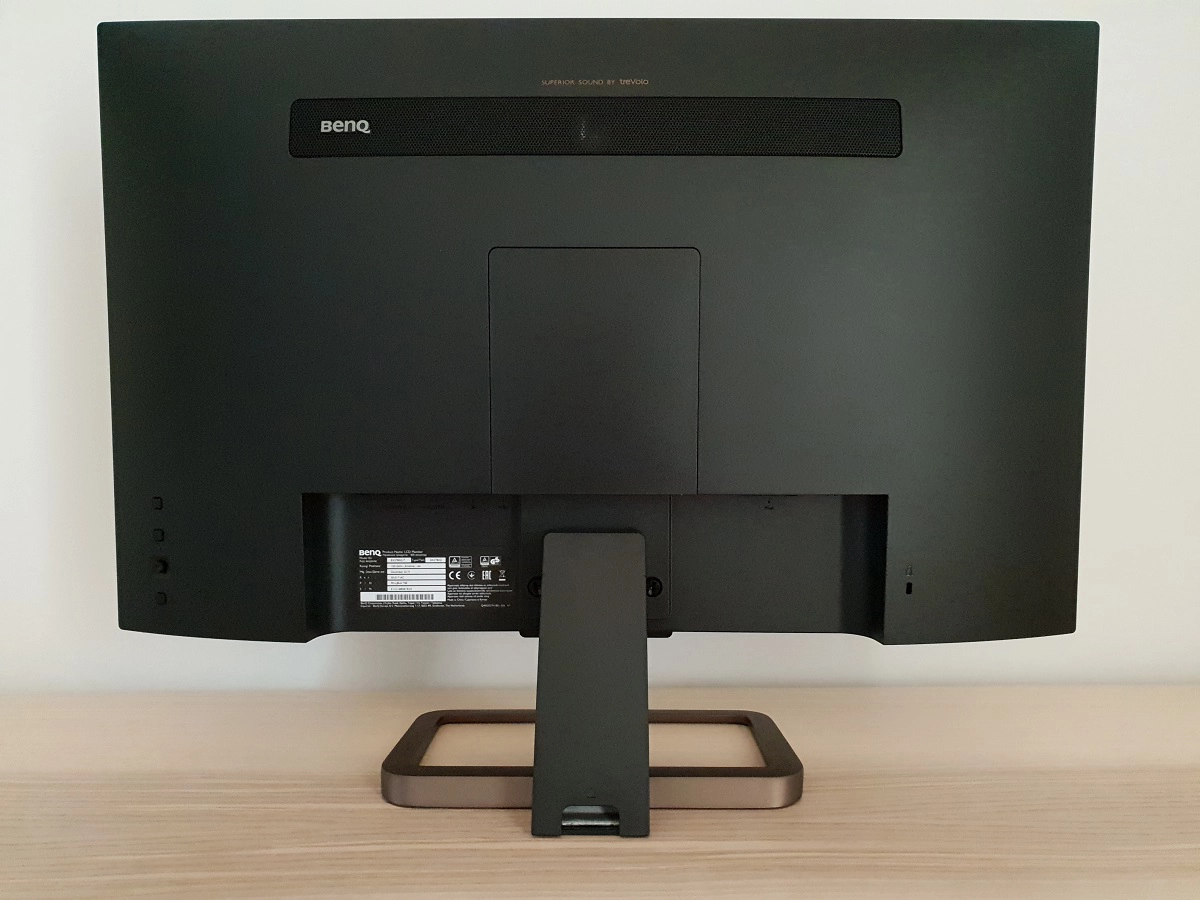
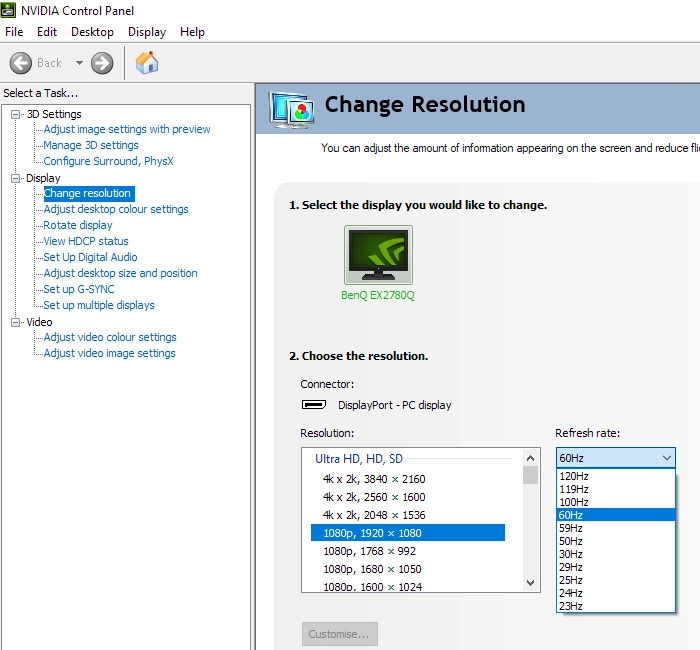
Calibration
Subpixel layout and screen surface
![]()
Testing the presets
Preset Mode Gamma (central average) White point (kelvins) Notes Standard (Factory Defaults) 2.2 6515K Good variety with a vibrant and varied appearance throughout the screen (strong colour consistency). A bit of a green push to the image but otherwise well-balanced. Gamma = 1.8 1.8 6584K As above but a significant reduction in depth and less saturated appearance overall due to significantly reduced gamma. Gamma = 2.0 2.0 6601K As above, a bit of an increase in depth and saturation due to slight gamma raise. Gamma = 2.4 2.4 6618K As per factory defaults but extra depth and saturation. Loss of detail for dark shades due to this, but quite a ‘cinematic’ appearance. Gamma = 2.6 2.6 6635K As above but extra depth and saturation with clear lack of distinction between darker shades. Rec. 709 2.2 6666K An effective sRGB emulation setting with very low default brightness (can be adjusted). Shades are significantly less saturated due to gamut corrections, but still show pleasing variety and consistency. Low Blue Light = Multimedia 2.2 6228K This is the weakest Low Blue Light (LBL) setting available on the monitor. A slight reduction in blue colour channel strength and hence slight reduction in blue light emitted. Imagine appears marginally warmer as a result. Low Blue Light = Web Surfing 2.2 5731K As above but a somewhat stronger reduction in blue light. The image appears noticeably warmer than factory defaults. The green colour channel is weakened relative to a strengthened red channel, so the image appears better balanced than many LBL implementations. Low Blue Light = Office 2.2 5224K As above but a further reduction in blue light output and an even warmer appearance. A very effective LBL setting. Low Blue Light = Reading 2.2 5018K As above with further reduction in blue light output. The effect is improved (with this and other settings) by also reducing the brightness. Low Blue Light = ePaper 3.1 4714K Combines significant blue light reduction with a greyscale filter. Everything appears as black, white or a shade of grey with warm overtones due to low colour temperature. User (Color Temperature = User Define) 2.2 6529K As factory defaults but significantly brighter and removal of the slight green tint. All colour channels are in their neutral position (‘100’), maximising contrast. Test Settings 2.2 6473K A vibrant and varied appearance to the image with pleasing gamma tracking and white point balance.
Straight from the box the monitor presented a vibrant and varied image with appropriate gamma tracking and white point. There was a slight green push, but this was easy to iron out using the OSD controls. The monitor provided a range of gamma settings that stayed true to their displayed targets, ranging from ‘1.8’ to ‘2.6’ in increments of ‘0.2’. The graph below shows gamma tracking under our ‘Test Settings’, following the desirable ‘2.2’ curve closely. Given the intended uses for monitor, inter-unit variation and pleasing performance following OSD tweaking alone we will not be using any ICC profiles for this review or including any measurements or graphs using them. We wouldn’t recommend using them unless created for your specific unit with your own calibration device. But we appreciate some users still like to use profiles and some aspects such as gamut mapping for colour-aware applications can be useful. You can download our ICC profile for this model if you wish, which was created using our ‘Test Settings’ as a base. But note again it is not used in this review. The monitor also included various easily accessible Low Blue Light (LBL) settings. The stronger settings proved useful in significantly reducing blue light output from the monitor. Especially when coupled with reduced brightness. The red channel was strengthened and green channel slightly weakened to help achieve a better balance to the image than some LBL settings. This comes at the expense of contrast, as explored shortly. Reducing blue light exposure is particularly important in the hours leading up to sleep as blue light is stimulating to the body and affects sleep hormones. It increases alertness and makes it more difficult to ‘shut off’. We used the ‘Reading’ setting for our own viewing comfort in the evenings but not for specific testing beyond that involving this exact setting. It’s also worth noting that the panel used in this monitor has a shifted blue light energy peak from the usual 450nm to 455nm, regardless of whether LBL settings are being used or not. This may not sound like much, but it’s an important viewing comfort consideration for some users. It’s enough to give a potentially ‘gentler’ or ‘less harsh’ look to the image compared to models using the more common and energetic 450nm blue peak. This includes models using current LG Nano IPS panels, such as the ViewSonic XG270QG. Our ‘Test Settings’ involved a significant reduction in brightness and slight colour channel adjustments. Note that individual preferences and units of the same model vary, so these settings should just be considered a suggestion. They aren’t going to be optimal for all users. Assume that any setting not mentioned here was left at default in the OSD, including ‘Contrast’ and ‘Gamma’. We’ve also included our preferred ‘AMA’ setting and the refresh rate used in Windows, just for reference. Note that these settings apply to SDR, which is used for the bulk of the review. HDR has separate settings associated with it and is explored in the relevant section of the review – our preference there was to set ‘HDR Mode’ to ‘Display HDR’. Brightness= 32 (according to preferences and lighting) Color Temperature = User Define R= 99 Green= 100 Blue= 99 AMA= Premium Refresh rate (Windows setting)= 144Hz We used an X-Rite i1Display Pro to measure white and black luminance levels, from which static contrast ratios could be calculated. The table below shows this data, with various settings used. Assume any setting not mentioned was left at default, except for the changes already noted in the calibration section. Black highlights indicate the highest white luminance and lowest black luminance recorded. Blue highlights indicate the results with HDR active and under our ‘Test Settings’.
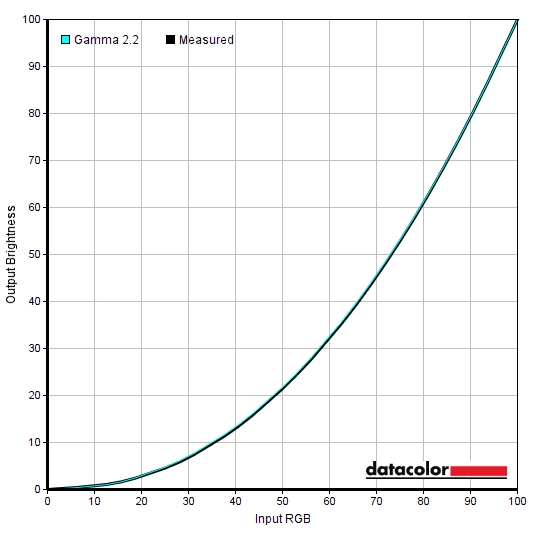
Gamma 'Test Settings'
Test Settings
Color Mode = User
Contrast and brightness
Contrast ratios
Monitor Settings White luminance (cd/m²) Black luminance (cd/m²) Contrast ratio (x:1) 100% brightness 371 0.35 1060 80% brightness (Factory Defaults) 312 0.29 1076 60% brightness 253 0.24 1054 40% brightness 191 0.18 1061 20% brightness 127 0.12 1058 0% brightness 60 0.06 1000 65% brightness (Factory Defaults) 268 0.25 1072 HDR Mode = Game HDRi (very bright room)* 495 0.45 1100 HDR Mode = Game HDRi (moderately bright room)* 301 0.28 1075 HDR Mode = Game HDRi (dark room)* 142 0.13 1092 HDR Mode = Cinema HDRi (very bright room)* 495 0.45 1100 HDR Mode = Cinema HDRi (moderately bright room)* 301 0.28 1075 HDR Mode = Cinema HDRi (dark room)* 142 0.13 1092 HDR Mode = Display HDR* 466 0.43 1084 Gamma = 1.8 268 0.25 1072 Gamma = 2.0 267 0.25 1068 Gamma = 2.4 268 0.25 1072 Gamma = 2.6 267 0.25 1068 Rec.709 87 0.08 1088 Low Blue Light = Multimedia 222 0.29 766 Low Blue Light = Web Surfing 193 0.26 742 Low Blue Light = Office 165 0.24 688 Low Blue Light = Reading 143 0.21 681 Low Blue Light = ePaper 145 0.33 439 User (Color Temperature = User Define) 377 0.35 1077 Test Settings 167 0.15 1113
*HDR measurements were made using this YouTube HDR brightness test video, running full screen at ‘1440p HDR’ on Google Chrome. The maximum reading from the smallest patch size (measurement area) that comfortably covered the entire sensor area and colorimeter housing was used for the white luminance measurement, which was ‘4% of all pixels’ in this case. The black luminance was taken at the same point of the video with the colorimeter offset to the side of the white test patch, equidistant between the test patch and edge of the monitor bezel.
The average contrast ratio with only brightness adjusted was 1052:1, close to the specified 1000:1 and fairly typical for an IPS-type model. The peak contrast was recorded under our ‘Test Settings’ (1113:1), although this was close to many of the other recorded values and partly due to rounding. Many of the settings tested maintained similar contrast levels, with a notable drop-off when using the ‘Low Blue Light’ settings. Particularly the stronger ones. This was expected due to the significant changes made to the colour channels. The highest white luminance recorded under SDR was 377 cd/m², whilst the minimum recorded white luminance was 60 cd/m². This gives a luminance adjustment range of 317 cd/m², with a reasonably but not exceptionally low minimum luminance.
The monitor offers no local dimming and therefore there was no contrast benefit under HDR. The peak luminance recorded was 495 cd/m², using the ‘Game HDRi’ and ‘Cinema HDRi’ modes in a very bright room. And by this, we mean lots of sunlight streaming into the room on a bright day. These settings respond to ambient lighting using the ‘B.I.+’ technology discussed shortly, so the backlight brightness is raised as much as possible to try to compete with that bright ambient light. Dimmer luminance values were recorded in a moderately bright room (fairly bright day but no sun streaming directly in) and significantly dimmer in a dark room. Even in a moderately bright room the recorded luminance level was distinctly ‘non-HDR’ in terms of brightness levels and a fair bit below the peak luminance recorded under SDR even. The ‘Display HDR’ setting provided a rather bright 466 cd/m², although this was held back slightly due to the fact the test uses a white square surrounded by black rather than a white screen fill. This is more representative of actual viewing conditions, though, as you wouldn’t typically have the entire screen displaying white.
A ‘Dynamic Contrast’ setting is included, available in some presets under SDR if ‘B.I.+’ is disabled. You can set this between ‘1’ and ‘5’, where higher numbers increase the speed of response to changes in scene brightness. The backlight adjusts, as a single unit (global dimming), to changes in the levels of light and dark in the scene. Even for mixed content with plenty of dark elements we found things brighter than we’d like with this setting active. As usual we prefer manual control of brightness over using this kind of setting under SDR and feel ‘Dynamic Contrast’ is just a compromised solution that fails to account for the mixtures of light and dark in a scene.
B.I. + (Brightness Intelligence Plus)
B.I.+ (Brightness Intelligence Plus) is an ‘enhanced’ Dynamic Contrast setting of sorts. As with Dynamic Contrast, adjustments are made to backlight brightness and some other elements of the image based on the content itself. But additional and potentially more significant adjustments are made according to room lighting conditions, read by the light sensor in the centre of the bottom bezel. As with the regular Dynamic Contrast mode the backlight is controlled as a single unit, without local dimming. ‘B.I.+’ can be activated using the dedicated key on the OSD remote or under ‘Eye Care’ – ‘B.I.+ (Brightness Intelligence Plus)’ in the menu system. It’s forced on under HDR if either the ‘Game HDRi’ or ‘Cinema HDRi’ is selected as the ‘HDR Mode’. Adjustments are made to brightness and colour temperature. As shown in the OSD video, you can also adjust the sensor sensitivity between ‘0’ and ‘100’ in increments of 10. This is designed to give you a small amount of flexibility if you find it is too reactive to relatively slight changes in ambient brightness. The ‘B.I.+’ setting is applied on top of presets and various other adjustments you might make in the OSD (under SDR). If for example you had a Low Blue Light (LBL) setting active, it would bias the colour temperature towards a warmer setting.
We’ve already explored this setting in our review of one of the first BenQ models to feature it, the EW2770QZ. The technology worked in much the same way on this model. Suffice to say we didn’t much like the feature and found the adjustments it was constantly making to the image to be inappropriate and at times obnoxious. Everybody has different sensitivity to brightness and having the monitor decide what it sets this at, with no flexibility whatsoever, is a flawed approach. Constant changes there were annoying. The changes to colour temperature didn’t fit with our preferences based on time of day or room lighting, either. Under HDR this technology was an equally curious addition. The ‘HDR10’ pipeline is designed with a certain set of parameters in mind and is supposed to involve close coordination between the content, GPU and game. With very specific and tightly controlled changes made to the image. It’s also designed to promote strong brightness beyond what you’d expect under SDR, even if the room lighting isn’t super bright itself. The ‘B.I.+’ element added on top of this just seemed awkward and we often found it skewing the image in unagreeable ways, much as we observed under SDR.
PWM (Pulse Width Modulation)
The EX2780Q does not use PWM (Pulse Width Modulation) to regulate backlight brightness at any level and instead uses DC (Direct Current). The monitor is therefore considered ‘flicker-free’, which will come as welcome news to those sensitive to flickering or worried about side-effects from PWM usage.
Luminance uniformity
Whilst observing a black background in a dark room, using our ‘Test Settings’, we noticed moderate backlight bleed and some clouding. There was a particularly prominent patch of backlight bleed and surrounding clouding towards the bottom left. Note that individual units vary when it comes to backlight bleed and clouding. The results on our unit are shown in the image below, taken some distance back to eliminate ‘IPS glow’. This is visible most clearly towards the bottom corners of the screen, from a normal viewing position. It appears cool-tinted towards the bottom left and warm-tinted towards the bottom right. It ‘blooms out’ from sharper viewing angles and in some regions of the screen appears particularly noticeable due to the strongly cool-tinted or quite strong golden bloom. This behaviour is shown in the viewing angles video deeper into the review. The luminance uniformity was pleasing overall. The brightest point recorded was ‘quadrant 5’ in the centre of the screen (160.3 cd/m²). The maximum deviation from this occurred at ‘quadrant 8’, below the central region (142.4 cd/m², which is 11% dimmer). The average deviation between each quadrant and the brightest point was just 4.63%, which is strong. It’s important to remember that uniformity varies between individual units and you can also expect variation beyond the points measured. The contour maps below show these deviations graphically, with darker greys representing lower luminance and hence greater deviation from the brightest recorded point than lighter greys. Percentage deviations between each quadrant and the brightest point are also given. The SpyderX Elite was also used to analyse variation in the colour temperature (white point) for the same 9 quadrants, shown below. The deviation between each quadrant and the quadrant closest to the 6500K (D65) daylight white point target was analysed and a DeltaE value assigned. A DeltaE >3 represents significant deviation that most users could readily notice by eye. The colour temperature uniformity was less impressive than the brightness uniformity. Significant deviation was recorded in 3 of the 8 quadrants, with the central quadrant measured as closest to 6500K. The maximum deviation recorded was DeltaE 4.2 towards the bottom left – not a massive deviation, but certainly still significant. Casually observing the screen revealed a noticeably warmer tint to white and light shades in this region – again, not a huge difference but still observable during normal use. Note again that individual units vary when it comes to uniformity and that deviation beyond measured points can be expected. The monitor provided a reasonable contrast performance on Battlefield V. Brighter elements stood out quite well against darker surroundings. The fairly smooth screen surface gave these brighter elements a reasonably smooth look, without the obvious graininess imparted by some matte screen surfaces. Darker elements such as dimly lit building interiors lacked the depth and atmosphere shown on models with much stronger static contrast, but were decent in this respect for an IPS-type panel. There was a moderate amount of ‘IPS glow’, lightening up darker elements towards the bottom corners of the screen in particular. This was particularly noticeable on our sample towards the bottom left, where it was brought out by moderate backlight bleed in this region. The cooler tint to the glow in this region also made it more eye-catching. The monitor was free from the perceived gamma shifts associated with VA and moreover TN panels, where perceived gamma can be much lower further down the screen or towards the sides. Finer details therefore looked appropriately blended rather than brought out in a way that looks artificial or ‘blocky’. We made similar observations on Shadow of the Tomb Raider. This title demands a strong contrast performance as there are plenty of dark caves sparsely illuminated interior spaces. The static contrast of this model coupled with ‘IPS glow’ (and dark uniformity issues on our unit) certainly didn’t provide a stunning atmosphere to such elements. Although the overall depth and atmosphere was reasonable for the panel type, for the central mass of the screen, and far from poor in an appropriately lit room. The fairly smooth screen surface kept brighter elements such as fires and daylight skies looking quite smooth without an obvious layer of graininess or ‘smeary’ appearance. There is just a light ‘misty’ graininess to such elements, which most users won’t find bothersome and many won’t even notice at all. We also made observations using the film Star Wars: The Last Jedi. There are plenty of scenes on this film that involve stark contrasts, with bright light elements such as explosions set against much darker backgrounds. The film didn’t share the sort of cinematic or atmospheric look that models with much stronger static contrast would provide but it was enjoyable to watch under appropriate room lighting. The fairly smooth screen surface helped the brighter elements appear quite smooth without obvious graininess, whilst the consistent gamma handling avoided excessive detail for darker elements. On models afflicted by perceived gamma changes at different regions of the screen, most notably TN models where perceived gamma is much lower further down the screen, this can really spoil the atmosphere on video content. It can be a particular issue for heavily compressed streamed content, where so-called compression artifacts are brought out in an obvious way, making some scenes appear blocky or artificial. No such issues with this model, due to appropriate gamma handling and strong consistency. The Lagom tests for contrast allow specific weaknesses in contrast performance to be identified. The following observations were made. The BenQ EX2780Q’s colour gamut (red triangle) was compared with the sRGB (green triangle) and DCI-P3 (blue triangle) reference colour spaces using our ‘Test Settings’, as shown below. The first image shows the results using our Nvidia GPU, used for most of our testing. The second image shows the results using our AMD GPU. The gamut fully covers sRGB, with significant extension beyond. According to our measurements using our Nvidia GPU, the monitor covers 94% DCI-P3, close to the 95% specified by the manufacturer. For the AMD GPU 95% DCI-P3 coverage was recorded, with just a little more extension in the red region compared to with the Nvidia GPU. Although not shown in the graphic, 90% Adobe RGB coverage was achieved. This sort of colour gamut is appropriate for HDR content, where DCI-P3 is the target colour space and hence good coverage of this is desirable. It also gives the monitor the potential to output all shades in the sRGB colour space (for normal SDR content) with quite a bit of extra vibrancy and saturation. The gamut below shows results using our ‘Test Settings’ with this driver tweak applied. The colour gamut now fully covers sRGB (100%) with only a small amount of extension beyond. This is a useful setting if you’re an AMD user and wish to gain close tracking of the sRGB gamut without profiling, including in applications that aren’t colour-managed. On Battlefield V the monitor provided a vibrant and varied look to things. Most SDR content, including what we’re observing here, is designed with the sRGB colour space in mind. If a monitor’s gamut extends beyond this then saturation levels are increased, as was the case here. Saturation is increased in an even and fairly universal way, without shade variety being adversely affected. Roaring flames were a good example of this, with some excellent strong oranges and reds plus a nice variety of yellows. Some of the yellows appeared too orange and some of the oranges verged on red, but the variety was still there. This contrasts with digital saturation enhancement (such as ‘Nvidia Digital Vibrance’ or the ‘Color Vibrance’ feature of the monitor) where shades are simply pulled closer to the edge of the gamut without the gamut itself being expanded. Under such conditions these same fires appear cartoonish with a lack of shade variety and generally less vibrant and saturated reds. Many users will appreciate the vibrant and varied look of the BenQ, but others appear a more natural and muted appearance in-line with the original sRGB intentions of the developers. Shadow of the Tomb Raider provided a similar experience. There was a nice range of deep and lush greens, alongside a good palette of more muted shades. Saturation was again stronger than intended for many of these shades, but the variety remained and things didn’t look ‘cartoonish’ for this reason. Skin tones in this game and woody tones had some red hues which were brought out a bit too strongly by the colour gamut, but this was not extreme in our view. Lara Croft appeared to have something of a ‘healthy’ tan rather than appearing sunburnt of lobster-like. Speaking of lobsters, we also observed various episodes of the animated TV series Futurama. There are large blocks of individual colour on this title, highlighting weaknesses in colour consistency very readily. The monitor performed well in this respect. The red of Dr Zoidberg (a talking lobster-like creature) appeared rich and punchy regardless of where on the screen he appeared, for example. Contrasting with VA and moreover TN panels where the red would appear less saturated in some regions of the screen. There were some nice vibrant neon shades such as greens and oranges. Whilst muted pastel shades appear more saturated than they should, the variety was maintained and they still appeared much more muted than the more lively shades. Lagom’s tests for viewing angle help explore the idea of colour consistency and viewing angle performance. The following observations were made from a normal viewing position, eyes around 70cm from the screen. Sitting closer to the screen exaggerates the slight shifts explored here. On some monitors, particularly but not exclusively those with high refresh rates, interlace patterns can be seen during certain transitions. We refer to these as ‘interlace pattern artifacts’ but some users refer to them as ‘inversion artifacts’ and others as ‘scan lines’. They may appear as an interference pattern, mesh or interlaced lines which break up a given shade into a darker and lighter version of what is intended. They often catch the eye due to their dynamic nature, on models where they manifest themselves in this way. Alternatively, static interlace patterns may be seen with some shades appearing as faint horizontal or vertical bands of a slightly lighter and slightly darker version of the intended shade. We did not observe either artifact type on this monitor. A small utility called SMTT 2.0 was used alongside a sensitive camera to analyse the latency of the EX2780Q, with over 30 repeat readings taken to help maximise accuracy. Using this method, we calculated 3.41ms (around ½ a frame at 144Hz) of input lag. At 60Hz we measured a somewhat higher but still reasonable 8.74ms. The input lag measured here is influenced by both the element you ‘see’ (pixel responsiveness) and the element you ‘feel’ (signal delay). It indicates a very low signal delay at 144Hz, which even sensitive users shouldn’t find bothersome. Note that we don’t have the means to accurately measure input lag with Adaptive-Sync active in a variable refresh rate environment or with HDR active in an HDR environment. Our article on responsiveness explores key concepts related to monitor responsiveness. Chief amongst these is the concept of ‘perceived blur’, contributed to by both the movement of your eyes as you track motion on the screen and the pixel responses of the monitor. Your eye movement leads to most perceived blur you’ll observe on a modern monitor, but pixel responses also play an important role. A photography technique called ‘pursuit photography’ is also introduced in this article. This uses a moving rather than static camera to capture motion on a monitor in a way that reflects both key aspects of perceived blur. This contrasts with static photography or videos, which only reflect pixel responsiveness. The images below are pursuit photographs taken using the UFO Motion Test for ghosting, with the test running at 960 pixels per second. This is a good practical speed for capturing such photographs and highlights both elements of perceived blur nicely. The UFOs move across the screen from left to right at a frame rate matching the refresh rate of the display. All background shade levels (dark, medium and light) were used with the monitor set to various ‘AMA’ (Advanced Motion Acceleration) pixel overdrive settings; ‘OFF’, ‘High’ and ‘Premium’. The monitor was tested at 60Hz (directly below), 120Hz and 144Hz. The two final columns shows 2 reference displays, both set to what we consider their optimal pixel overdrive settings. The first reference display is the ViewSonic XG270QG, a fast and well-tuned IPS model showing only minor pixel response time weaknesses. The second reference display is the AOC AG273QCG, a fast and well-tuned TN model showing how things look where pixel responsiveness is very strong. At 60Hz (above), the UFOs appear relatively broad and unfocused, without sharp internal detailing. This reflects a moderate level of perceived blur due to eye movement. There is also varying levels of trailing behind the UFOs, which is down to weaknesses in pixel responsiveness. These are clearest with ‘AMA = OFF’, with a fairly distinct (although not extremely pronounced) ‘powdery’ trail. The ‘AMA = High’ setting cuts down on this and the ‘AMA = Premium’ setting shows a further reduction. With the ‘Premium’ setting this conventional trailing is replaced by moderate overshoot (inverse ghosting). You can see this as a bright ‘halo’ trail behind the UFOs. The ‘High’ setting is most similar to the reference shots (a good thing) and given the moderate overshoot using ‘Premium’, we’d consider this ‘High’ setting optimal at 60Hz. The images below show how things looked with a doubling of the refresh rate, to 120Hz. At 120Hz (above), the UFOs appear narrower with more distinct internal detailing. This reflects a significant reduction in perceived blur due to eye movement. There was an ever-decreasing degree of trailing behind the object as ‘AMA’ setting was increased. The ‘Premium’ setting introduced a little overshoot, particularly for the light background (bottom row). This was significantly weaker than at 60Hz and was only apparent for the light background. A fair degree of trailing remained for the dark background (top row), certainly more than for the reference screens. But for the medium background (middle row) there was a fair reduction in trailing going from ‘High’ to ‘Premium’. We consider the ‘Premium’ setting to be optimal at 120Hz. Below you can see how things look with a slight bump in refresh rate up to 144Hz. At 144Hz (above), things appear similar to 120Hz. The UFOs appear just slightly narrower and more sharply focused, reflecting a slight increase in perceived blur due to eye movement. The behaviour is very similar to 120Hz, with some of the ‘powdery’ trailing from pixel response time weaknesses extending a little further back. We’d again consider ‘Premium’ the optimal setting here, which is what we settled on for our ‘Test Settings’ and what was used for the subjective testing directly below. On Battlefield V, with the frame rate keeping pace with the refresh rate, the monitor provided a good fluid experience. The 144Hz refresh rate allowed the monitor to pump out up to 2.4 times as much information every second as a 60Hz monitor. This improved what we call the ‘connected feel’, which describes the fluidity and precision you feel when interacting with the game world. The low input lag also ensured it wasn’t a burden in that respect. The perceived blur was also reduced by the mechanisms explained and demonstrated earlier, due to this high frame and refresh rate combination. For the most part pixel responses were fast enough to provide a convincing 144Hz without significant additional perceived blur added. Just a little ‘powdery’ trailing in places or no clear additional trailing from pixel response time weaknesses. There was more noticeable ‘powdery’ trailing for some transitions, particularly where very light or dark shades moved against medium backgrounds. Moving against a dark rock against a dusk sky, for example. These pixel transitions were slower than on some of the faster IPS-type models, like the ViewSonic XG270QG. Whilst this added a bit to perceived blur and stood out a bit as a weakness, it was nowhere near as obvious as the weaknesses observed on even the fastest VA models we’ve come across. The LG 32GK850G being a good example. There was some overshoot observed in the form of ‘halo’ trailing that was somewhat brighter than the background or object colour. Usually where transitions involved medium to bright shades (a light-coloured tree trunk moving against a bright sky, for example). This wasn’t extreme overshoot nor was it widespread. Sensitive users may want to consider using the ‘High’ setting instead of our preferred ‘Premium’ setting to cut down on this, but we feel most will find the overshoot levels palatable. We made similar observations on Shadow of the Tomb Raider. This title has plenty of darker shades and very bright shades combined, as part of the dark and eery scenes that are common to the title. These brought about the sort of slight weaknesses described earlier with some of the more noticeable ‘powdery’ trailing. This was by no means excessive nor anywhere near as noticeable as a VA model performing similar transitions. There was also some overshoot for a minority of transitions, but neither this nor the ‘powdery trailing’ impeded our enjoyment on this title. The strong ‘connected feel’ was also an enjoyable addition, although for single player adventure titles like this much less relevant really. We also made observations using a range of video content, including 24 – 30fps Netflix content and 60fps YouTube content. There were no noticeable weaknesses for the lower frame rate content and only very minor ones for the higher frame rate content. Brief glimmers of overshoot or a very small amount of powdery trailing for a minority of transitions. Overall, there was little to complain about regardless of the movie content being watched. The monitor’s pixel responses were more than fast enough for a good performance here. The monitor also includes a 23Hz and 24Hz mode as noted earlier in the review, for those who like to minimise judder in 23-24fps content. As an Amazon Associate I earn from qualifying purchases made using the below link. Where possible, you’ll be redirected to your nearest store. Further information on supporting our work. AMD FreeSync is a variable refresh rate technology, an AMD-specific alternative to Nvidia G-SYNC. Where possible, the monitor dynamically adjusts its refresh rate so that it matches the frame rate being outputted by the GPU. Both our responsiveness article and the G-SYNC article linked to explore the importance of these two elements being synchronised. At a basic level, a mismatch between the frame rate and refresh rate can cause stuttering (VSync on) or tearing and juddering (VSync off). FreeSync also boasts reduced latency compared to running with VSync enabled, in the variable frame rate environment in which it operates. FreeSync requires a compatible AMD GPU such as the Radeon RX 580 used in our test system. There is a list of GPUs which support the technology here, with the expectation that future AMD GPUs will support the feature too. The monitor itself must support ‘VESA Adaptive-Sync’ for at least one of its display connectors, as this is the protocol that FreeSync uses. The EX2780Q supports FreeSync Premium via DP and HDMI on compatible GPUs and systems. HDR can be used at the same time. Recent AMD drivers make activation of the technology very simple and something that usually occurs automatically. You should ensure the GPU driver is setup correctly to use FreeSync, so open ‘AMD Radeon Software’, click ‘Settings’ (cog icon towards top right) and click on ‘Display’. You should then ensure that the first slider, ‘Radeon FreeSync’ is set to ‘Enabled’ as shown below. To configure VSync, open ‘AMD Radeon Software’. Click ‘Settings’ (cog icon towards top right) and click ‘Graphics’. The setting is listed as ‘Wait for Vertical Refresh’. This configures it globally, but if you wish to configure it for individual games click ‘Game Graphics’ towards the top right. The default is ‘Off, unless application specifies’ which means that VSync will only be active if you enable it within the game itself, if there is such an option. Such an option does usually exist – it may be called ‘sync every frame’ or something along those lines rather than simply ‘VSync’. Most users will probably wish to enable VSync when using FreeSync to ensure that they don’t get any tearing. You’d therefore select either the third or fourth option in the list, shown in the image below. Above this dropdown list there’s a toggle for ‘Radeon Enhanced Sync’. This is an alternative to VSync which allows the frame rate to rise above the refresh rate (no VSync latency penalty) whilst potentially keeping the experience free from tearing or juddering. This requires that the frame rate comfortably exceeds the refresh rate, not just peaks slightly above it. We won’t be going into this in detail as it’s a GPU feature rather than a monitor feature. We ran a range of game titles on this monitor with FreeSync enabled, finding as usual that the technology worked in much the same way on all of the game titles. Any issues identified on one specific title would suggest a game or GPU driver issue rather than a monitor issue. We’ll therefore simply focus on a single title for this section, which as usual will be Battlefield V. This is a good title to test Adaptive-Sync technology as it offers appropriate flexibility with graphics settings to allow the whole variable refresh rate range to be tested. The Radeon RX 580 used in our test system to test the technology is far from a powerhouse, so dips below 144fps were common. Without FreeSync, even slight dips in frame rate caused tearing (VSync disabled) or stuttering (VSync enabled). As users sensitive to such things, this can be rather bothersome and it’s very nice to have such interruptions removed by FreeSync. A reduction in frame rate still has negative consequences, though. Comparing ~100fps to ~144fps, for example, there’s a significant difference in perceived blur and connected feel. The experience was by no means poor at 100fps, but 144fps certainly have an edge regardless of FreeSync being active in both cases. As the frame rate dropped deeper into the double digits, the perceived blur increases further and the ‘connected feel’ ebbed away. It was still nice having FreeSync doing this thing, however. There was also an increase in overshoot, with some noticeable bright ‘halo’ trailing kicking in as things drop closer to 60fps or so. This is due to Adaptive-Sync models like this lacking the variable overdrive technology that models with a G-SYNC module offer. This re-tunes the pixel overdrive as refresh rate drops so things remain appropriately optimised, without excessive voltage surges that can cause strong overshoot. Fortunately, the monitor provided a well-balanced setting for these double-digit frame rates in the form of setting ‘AMA = High’. This offered a good experience at these reduced frame rates, without such noticeable overshoot. It also worked quite well at higher frame rates as well, but the increased pixel response time demands there meant that the ‘Premium’ setting was optimal there. When the frame rate dropped below the 48fps (48Hz) floor of operation, the monitor employed LFC (Low Framerate Compensation) to keep tearing and stuttering at bay. The refresh rate stuck to a multiple of the frame rate, which worked effectively. When LFC kicked in or deactivated, there was momentary stuttering – a potential issue if you frequently cross this boundary, otherwise not something to be concerned about. As noted earlier, AMD FreeSync makes use of Adaptive-Sync technology on a compatible monitor. As of driver version 417.71, users with Nvidia GPUs (GTX 10 series and newer) and Windows 10 can also make use of this Variable Refresh Rate (VRR) technology. When a monitor is used in this way, it is something which Nvidia refers to as ‘G-SYNC Compatible’. Some models are specifically validated as G-SYNC compatible, which means they have been specifically tested by Nvidia and pass specific quality checks such as the inclusion of effective variable overdrive. The make use of the technology, you need to connect the monitor up via DisplayPort. When you open up Nvidia Control Panel, you should then see ‘Set up G-SYNC’ listed in the ‘Display’ section. Ensure the ‘Enable G-SYNC, G-SYNC Compatible’ checkbox as well as ‘Enable settings for the selected display model’ is enabled as shown below. Press OK – the monitor should briefly flick off then on again and the technology should be active. Our suggestions regarding use of VSync also apply, but obviously you’re using Nvidia Control Panel rather than Radeon Software to control this. The setting is found in ‘Manage 3D settings’ under ‘Vertical sync’, where the final option (‘Fast’) is equivalent to AMD’s ‘Enhanced Sync’ setting. You’ll also notice ‘G-SYNC Compatible’ listed under ‘Monitor Technology’ in this section, as shown below. Make sure this is selected (it should be if you’ve set everything up correctly in ‘Set up G-SYNC’). On an ideal monitor, HDR (High Dynamic Range) involves very bright light shades and very deep dark shades being displayed simultaneously. It’s also necessary for the monitor to display an excellent variety of shades between these extremes, including highly saturated shades and much more muted pastel shades. Ideally the monitor would support per-pixel illumination (OLED etc.), or at least offer a very large number of dimming zones controlled with strong precision. An FALD (Full Array Local Dimming) solution with a very high number of dimming zones, in other words. This allows some areas of the image to remain very dim whilst others stay very bright. Colour reproduction is also an important part of HDR, with the ultimate goal being support for a huge colour gamut, Rec. 2020. A more achievable near-term goal is support for at least 90% DCI-P3 (Digital Cinema Initiatives standard colour space) coverage. Finally, HDR makes use of at least 10-bit precision per colour channel, so its desirable that the monitor supports at least 10-bits per subpixel. Monitors most commonly support the HDR10 pipeline, the most widely supported HDR standard used in HDR games and movies. For most games and other full screen applications that support HDR, the BenQ EX2780Q automatically switches into its HDR operating mode. As of the latest Windows 10 update, relevant HDR settings in Windows are found in ‘Windows HD Color settings’ which can be accessed via ‘Display settings’ (right click the desktop). Most game titles will activate HDR correctly when the appropriate in-game setting is selected. A minority of game titles that support HDR will only run in HDR if the setting is active in Windows as well. Specifically, the toggle which says ‘Play HDR games and apps’. If you want to view HDR movies on a compatible web browser, for example, you’d also need to activate the ‘Stream HDR Video’ setting. These settings are shown below. Also note that there’s a slider that allows you to adjust the overall balance of SDR content if HDR is active in Windows. This is really just a digital brightness slider, so you lose but never gain contrast by adjusting it. When viewing SDR content with HDR active in Windows it looks more appealing than on some models, but there is a distinct over-sharpening and a lack of depth with generally upset image balance. We’d recommend only activating HDR in Windows if you’re about to specifically use an HDR application that requires it, and have it deactivated when viewing normal SDR content on the monitor. For this section we’ll focus on two titles; Battlefield V and Shadow of the Tomb Raider. We’ve tested many HDR-capable monitors on these and similar titles and know that they offer a good implementation that tests monitor capabilities appropriately. Although this testing is focused on HDR PC gaming using DisplayPort, similar observations were made using HDMI. The observations apply more broadly to other HDR content including HDR movies and running HDR on compatible games consoles. The experience described here is largely dictated and limited by the screen itself. There are three ‘HDR Mode’ settings on the monitor; ‘Game HDRi’, ‘Cinema HDRi’ and ‘Display HDR’. As mentioned earlier, these act as emulation modes when an SDR signal is detected and change how the monitor reacts to an HDR signal when that is detected. ‘Game HDRi’ and ‘Cinema HDRi’ incorporate the ‘Brightness Intelligence +’ functionality, which as we’ve already covered isn’t a feature we like to use under either SDR or HDR. The image tended to appear too blue and not at all ‘HDR-like’ in most lighting conditions using either setting. The ‘Cinema HDRi’ setting ramped up the gamma as well, making things appear overly deep although quite ‘cinematic’ which seems appropriate given the name of the setting. Needless to say, we preferred the ‘Display HDR’ setting and will be focusing on that for the remainder of this section. The HDR modes all include a sharpness filter (extra sharpness) applied strongly by default. This is usual under HDR as it helps slightly accentuate the improved shade precision and (not applicable on this model) enhanced contrast under HDR. You can adjust this according to preferences using the ‘Sharpness’ control in the ‘Picture’ section of the OSD. A flexibility most monitors don’t give you under HDR. The BenQ EX2780Q is VESA DisplayHDR 400 certified. This is the lowest level that VESA certifies for and therefore means that only a basic HDR experience is offered. One area of the VESA DisplayHDR 400 requirements are not just met but comfortably exceeded is colour gamut. We recorded a colour gamut of 94% DCI-P3 on the BenQ, as shown in the gamut representation below. This is taken from the colour reproduction section of the review, with the red triangle showing the monitor’s colour gamut, the blue triangle DCI-P3 and the green triangle sRGB. Because DCI-P3 is the near-term standard game developers and HDR movie directors have in mind when creating HDR content, it makes sense to have good coverage of this colour space for HDR purposes. This more accurate use of the gamut took an edge off the saturation levels, making things appear more natural and appropriate. Removing an overly red hue from tree trunk and weakening some of the overly powerful yellowish green hues of some vegetation on both of the test titles. Strong saturation was maintained where it was wanted by the developers, though. Roaring flames, some lush forest greens and brightly painted objects showcased a palette of shades that was well beyond the boundaries of sRGB. This is a daylight scene with a mixture of very bright, bright and somewhat dimmer content. The monitor provided decent brightness thanks to its moderately powerful backlight, more so than many VESA DisplayHDR 400 level displays. The peak luminance was some way off higher level HDR displays (VESA DisplayHDR 1000 and above in particular), so the bright elements such as the glint of light on the water and reflection from the waxy leaf surface weren’t as brilliant as they could be. A key reason such elements didn’t really stand out in the same way as on some more accomplished HDR performers, though, is a lack of local dimming on the backlight. Ideally this strong backlight luminance would only be used to help give localised ‘pop’ to those very bright elements, whilst the darker surroundings were kept much deeper. That also gives a more natural look to daylight scenes such as this, but with such capability lacking here it really didn’t achieve the proper ‘HDR look’. We also noticed that whilst a degree of Dynamic Contrast was used, the backlight tended to stay on to quite high levels during predominantly dark scenes. It can’t shut off completely unless the scene is pure black, which would be rather uninteresting and rare in a game. But it tended to stay on the brighter rather than dimmer side even with mostly dark content being displayed. This created a flooded look to such scenes, exacerbated by ‘IPS glow’ which was brought out strongly. The section of the video review below focuses on the HDR performance of the monitor and runs through some examples on both test titles. It might be desirable or necessary to run the monitor at a lower resolution than the native 2560 x 1440, either to reduce graphical horsepower demands or due to using a device such as a games console which doesn’t support the resolution. The monitor supports scaling functionality via any of its display inputs, up to a maximum of 120Hz. A wide array of refresh rates are supported at the Full HD resolution, whilst ‘4K’ UHD downsampling is also supported – as covered at the end of the features and aesthetics section. To ensure the monitor rather than GPU is handling the scaling process, you need to make sure the GPU driver is set up correctly. For AMD GPU users the monitor will handle the scaling by default, when gaming at non-native resolutions. Nvidia users should open the Nvidia Control Panel and navigate to ‘Display – Adjust desktop size and position’. They should ensure that ‘No Scaling’ is selected and ‘Perform scaling on:’ is set to ‘Display’ as shown below. There are three scaling modes listed under ‘Picture’ – ‘Advanced’ – ‘Display Mode’ in the OSD; ‘Full’, ‘Aspect’ and ‘1:1’. The ‘Full’ setting uses an interpolation process to use all pixels on the screen to display the image. The ‘Aspect’ setting will do the same whilst respecting the aspect ratio of the source resolution (it’s greyed out if a 16:9 resolution is selected). The ‘1:1’ setting is a 1:1 pixel mapping mode which will only use the pixels called for in the source resolution when displaying an image. A black border will be displayed for remaining pixels. Considering the 1920 x 1080 (‘1080p’ Full HD) resolution, this was displayed in a somewhat softer way than on a native Full HD monitor of similar size. This softening was not extreme, though, with the image appearing somewhat sharper and more detailed than some interpolation processes we’ve come across. Furthermore, the monitor offers good flexibility in the ‘Picture’ section of the OSD to increase sharpness. Whilst it isn’t a substitute for having the correct number of pixels for the resolution displayed, it does allow some adjustment according to taste. There is ‘Sharpness’ which can be set between ‘1’ and ‘10’ in single unit increments, with a default value of ‘5’. There’s also ‘Super Resolution’ which can be set between ‘1’ and ‘3’ with a default value of ‘0’ (off). This sharpness filter is applied a bit differently and can be combined with changes to ‘Sharpness’. Quite nice flexibility and by all accounts one of the better interpolation processes we’ve come across. As usual, if you’re running the monitor at 2560 x 1440 and viewing 1920 x 1080 content (for example a video over the internet or a Blu-ray, using movie software) then it is the GPU and software that handles the upscaling. That’s got nothing to do with the monitor itself – there is a little bit of softening to the image compared to viewing such content on a native Full HD monitor, but it’s not extreme and shouldn’t bother most users. The video below shows the monitor in action. The camera, processing done and your own screen all affect the output – so it doesn’t accurately represent what you’d see when viewing the monitor in person. It still provides useful visual demonstrations and explanations which help reinforce some of the key points raised in the written piece. By combining a 27” 2560 x 1440 IPS-type panel with 144Hz refresh rate, the BenQ EX2780Q hits exactly the sort of sweet spot that many gamers and other PC users are after. The resolution itself provides a nice useable pixel density and is a generally agreeable compromise between clarity, readability and GPU horsepower requirements. The monitor stands out amongst the crowd with its rustic styling, something which will appeal to some but not others. We found it blended in quite nicely with its largely wooden surroundings of our desk space, but looks and styling is subjective. A few other noteworthy additions to this model include the IR remote, which we found very useful. Integrated speakers with an accompanying subwoofer, giving more bite than usual for integrated monitor speakers. And a light sensor that can be used with the manufacturer’s unique ‘B.I.+’ feature – but the less said about that, the better. The main strength of this model, as usual for an IPS-type monitor, was the colour reproduction. Combined with a generous ~95% DCI-P3 colour gamut, shades were reproduced in a consistent and vibrant way. For those who prefer their shades more ‘true to form’ for sRGB content, an effective sRGB emulation setting (‘Rec.709’) was included. Unlike some sRGB emulation settings, you regain full control over brightness and there was no significant hit in contrast. Speaking of contrast, this was not largely as we’d expect from the panel type. There was a moderate amount of ‘IPS glow’, exacerbated in places by the moderate backlight bleed on our unit as well (mileage there may vary). So darker content was hardly deep and atmospheric. Nonetheless, brighter shades still contrasted well against darker surroundings. Gamma was consistent, keeping detail levels relatively even throughout the screen without the sort of perceived shifts associated with TN or VA panels. The light matte screen surface with fairly smooth surface texture kept the image free from obvious graininess or a ‘layered’ appearance, too. The responsiveness of the monitor was quite impressive overall, without any showstopping weaknesses. Input lag was low and most pixel responses were fast enough to put the 144Hz refresh rate to good use. There was some weaknesses in terms of pixel responsiveness, with this monitor distancing itself from the best IPS-type performers (e.g. XG270QG) and fast TN models. But nothing that stood out or potentially interfered with gaming enjoyment in the same way as VA pixel response weaknesses. Adaptive-Sync was also supported, working well to get rid of tearing and stuttering from the frame and refresh rate mismatches that would otherwise occur. This worked well on both our AMD GPU (AMD FreeSync) and Nvidia GPU (‘G-SYNC Compatible Mode’), with the only slight difference we observed being to the floor of operation for the technology. Below this, the monitor used a multiple of the frame rate with its refresh rate to keep tearing and stuttering at bay. This model is also VESA DisplayHDR 400 compliant. Provided an appropriate HDR setting was used, which avoided bringing the ‘B.I.+’ technology into the equation, the HDR implementation was decent for HDR at this ‘level’. With that said, the peak luminance was good but not spectacular for HDR and there was no local dimming. Hence no boost in contrast. The colour gamut was put to good use and 10-bit colour was supported for HDR, albeit using some GPU-side dithering at 144Hz, for enhanced precision. So all in all, the monitor provided a competent all-round performance with some unique features. It’s important to add price into the equation, which at time of review and based on US pricing, sees this sitting alongside the ViewSonic XG270QG. The ViewSonic has a full G-SYNC module, 165Hz refresh rate, somewhat superior pixel responsiveness and fully adjustable stand. It also takes the price above some competing models like the Gigabyte AORUS FI27Q-P, arguably a more feature-rich model using the same panel. Depending on local pricing and your own preferences for some of the unique BenQ features, we think this model is worth strong consideration. The bottom line; a competent all-round performer with some unique features – a good mix of colour quality and responsiveness, but the contrast experience on our unit and pricing in some regions was less impressive.
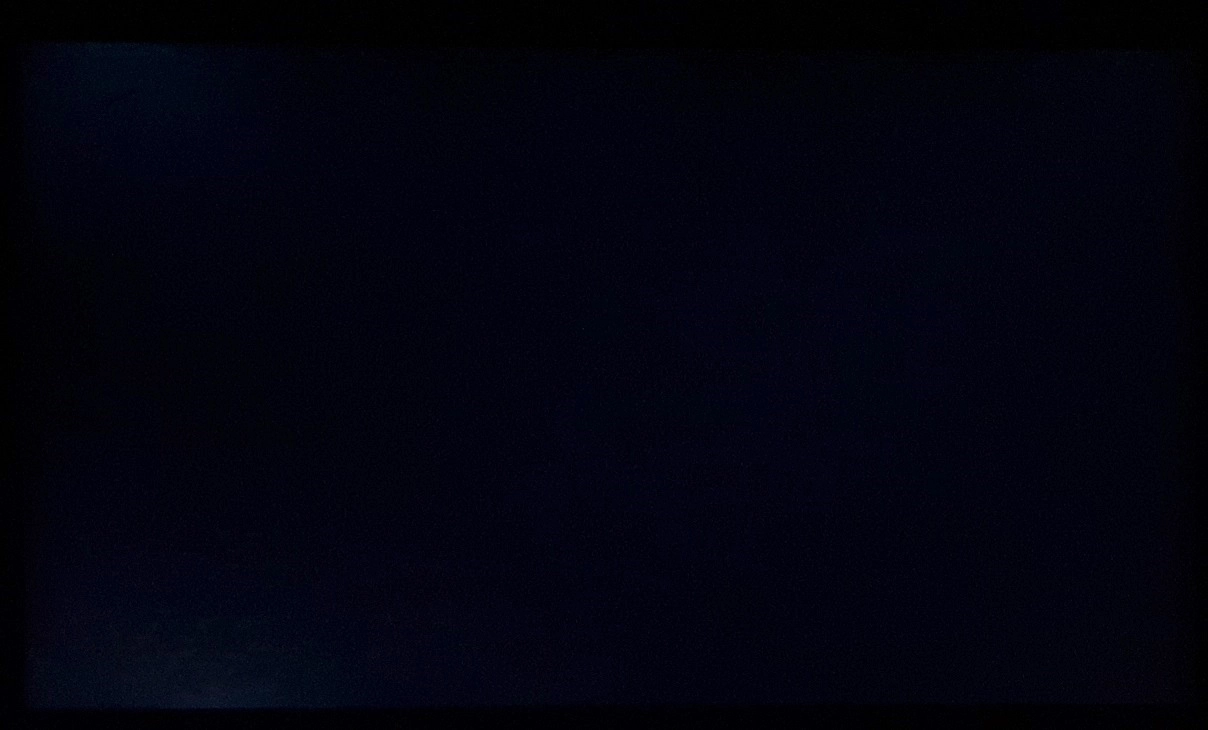
The SpyderX Elite was used to assess the uniformity of lighter shades, represented by 9 equidistant white quadrants. The luminance of each quadrant was measured and compared to the brightest measured quadrant. The table below shows these values as well as the percentage deviation between each quadrant and the brightest point measured.

Luminance uniformity table
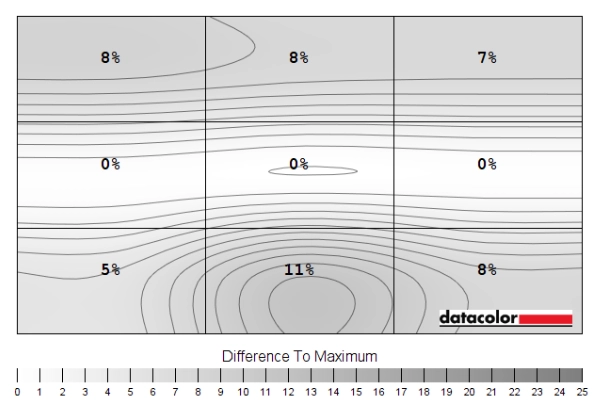
Luminance uniformity map

Colour temperature uniformity map
Contrast in games and movies
Lagom contrast tests
Colour reproduction
Colour gamut
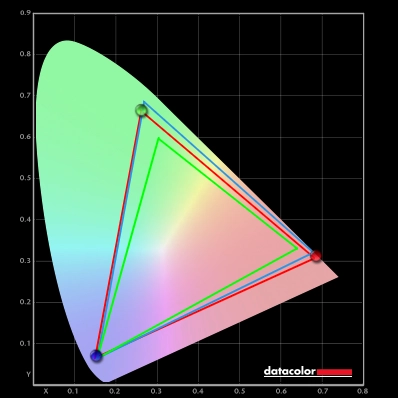
Colour gamut 'Test Settings' Nvidia GPU
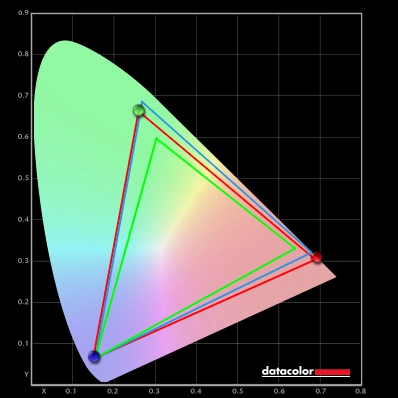
Colour gamut 'Test Settings' AMD GPU
The monitor also offers an sRGB emulation setting – setting the ‘Color Mode’ to ‘Rec.709’ in the ‘Color’ section of the OSD. As mentioned earlier you can adjust brightness when using this setting, although the colour channels are not accessible. The colour gamut using this setting is shown below, with things now tracking closer to the sRGB colour space. There’s a little undercoverage (98% sRGB) but very little extension beyond sRGB. If you have a colour-managed workflow you’d get the highest levels of accuracy by full calibration and profiling with a colorimeter or similar device using the full native gamut. But the ‘Rec.709’ setting offers reliable emulation of the sRGB colour space where this is not possible. Alternatively, you may wish to try the ICC profile featured in the calibration section which includes gamut mapping for colour-aware applications whilst the monitor uses its native colour gamut. Best results are always obtained by calibrating your own unit with your own hardware, however.

Colour gamut 'Rec.709'
Instead of setting ‘Color Mode’ to ‘Rec.709’ and putting up with the restrictions associated with that, AMD users can activate an sRGB emulation setting with superior sRGB coverage and flexibility. This is done by opening ‘AMD Radeon Software’, clicking ‘Settings’ (cog icon towards top right) and clicking on ‘Display’. You should then ensure that the ‘Custom Color’ slider to the right is set to ‘Enabled’ and ‘Color Temperature Control’ set to ‘Disabled’. This is shown in the image below.

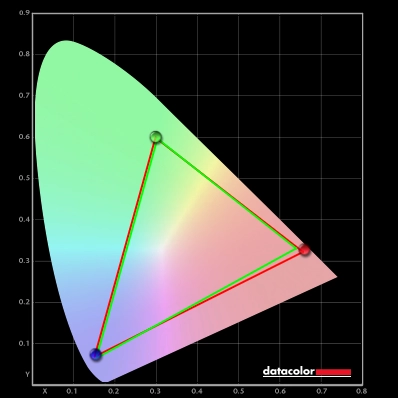
Colour gamut AMD 'CTC disabled' setting
Colour in games and movies
Viewing angles
Interlace pattern artifacts
Responsiveness
Input lag
Perceived blur (pursuit photography)
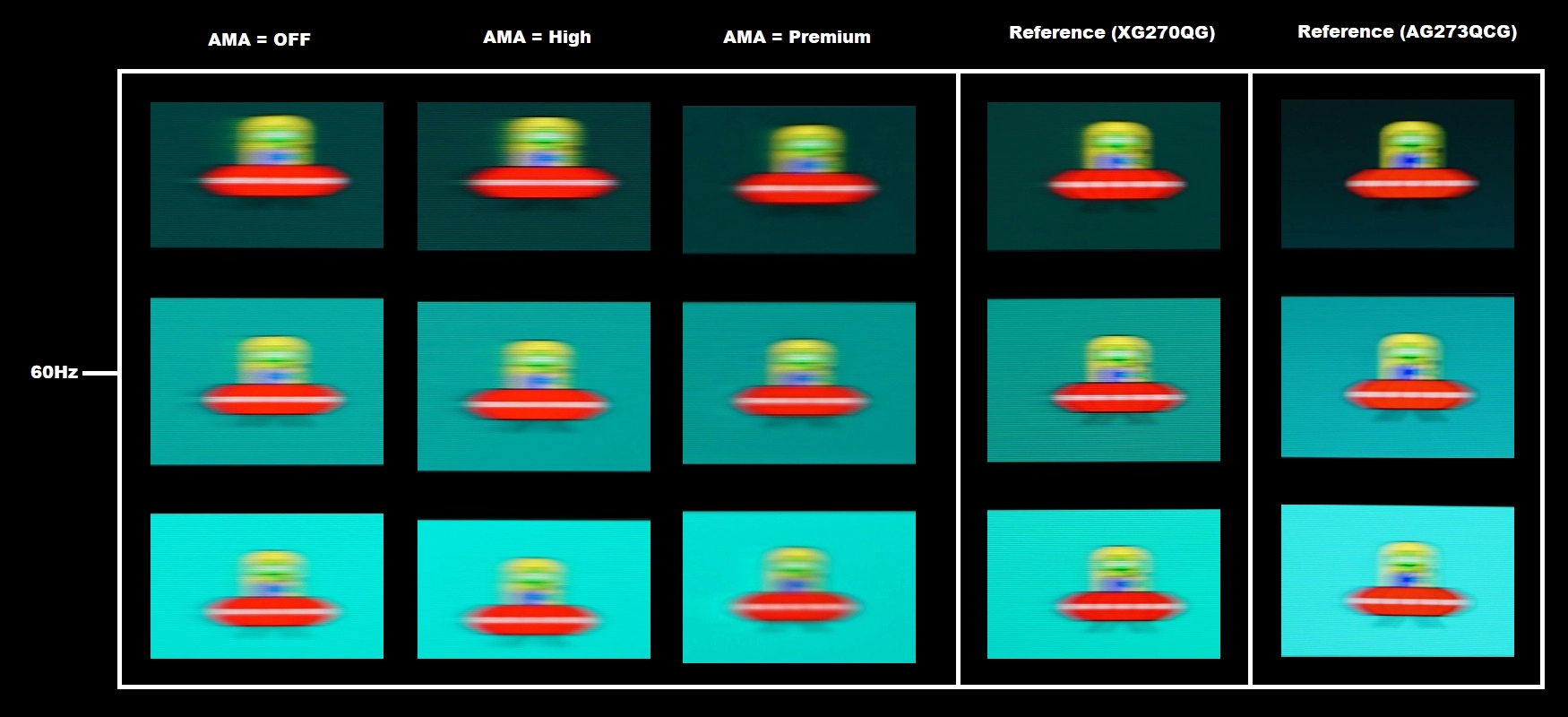
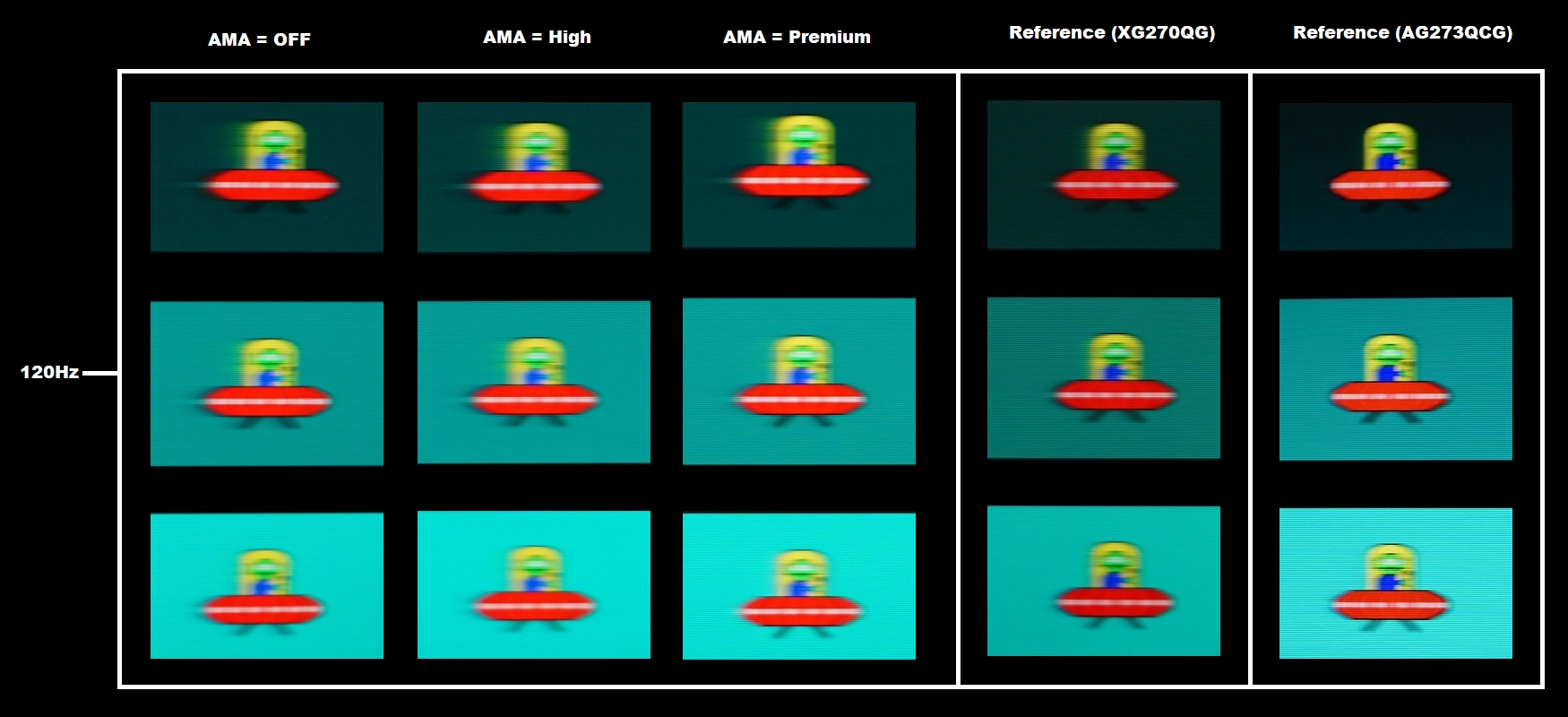
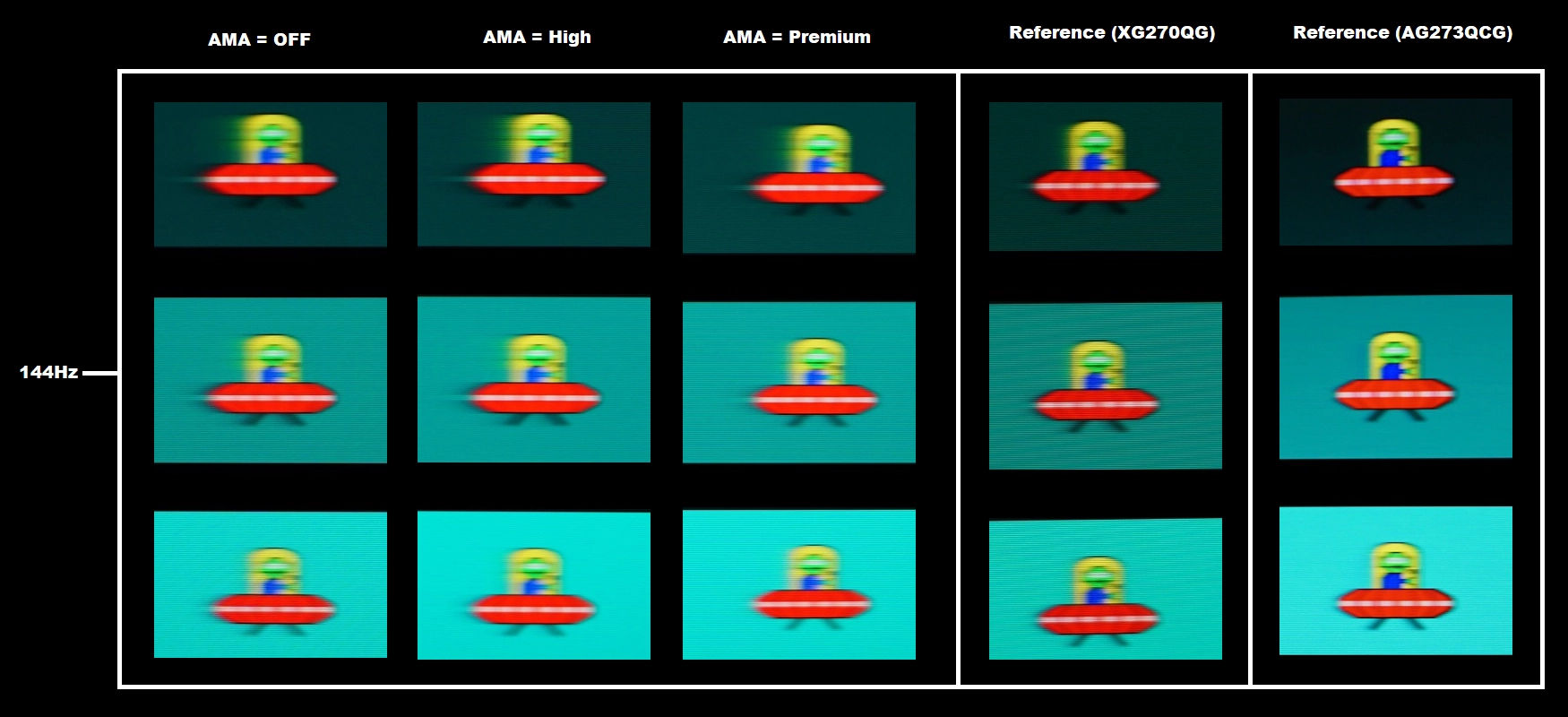
Responsiveness in games and movies

FreeSync – the technology and activating it
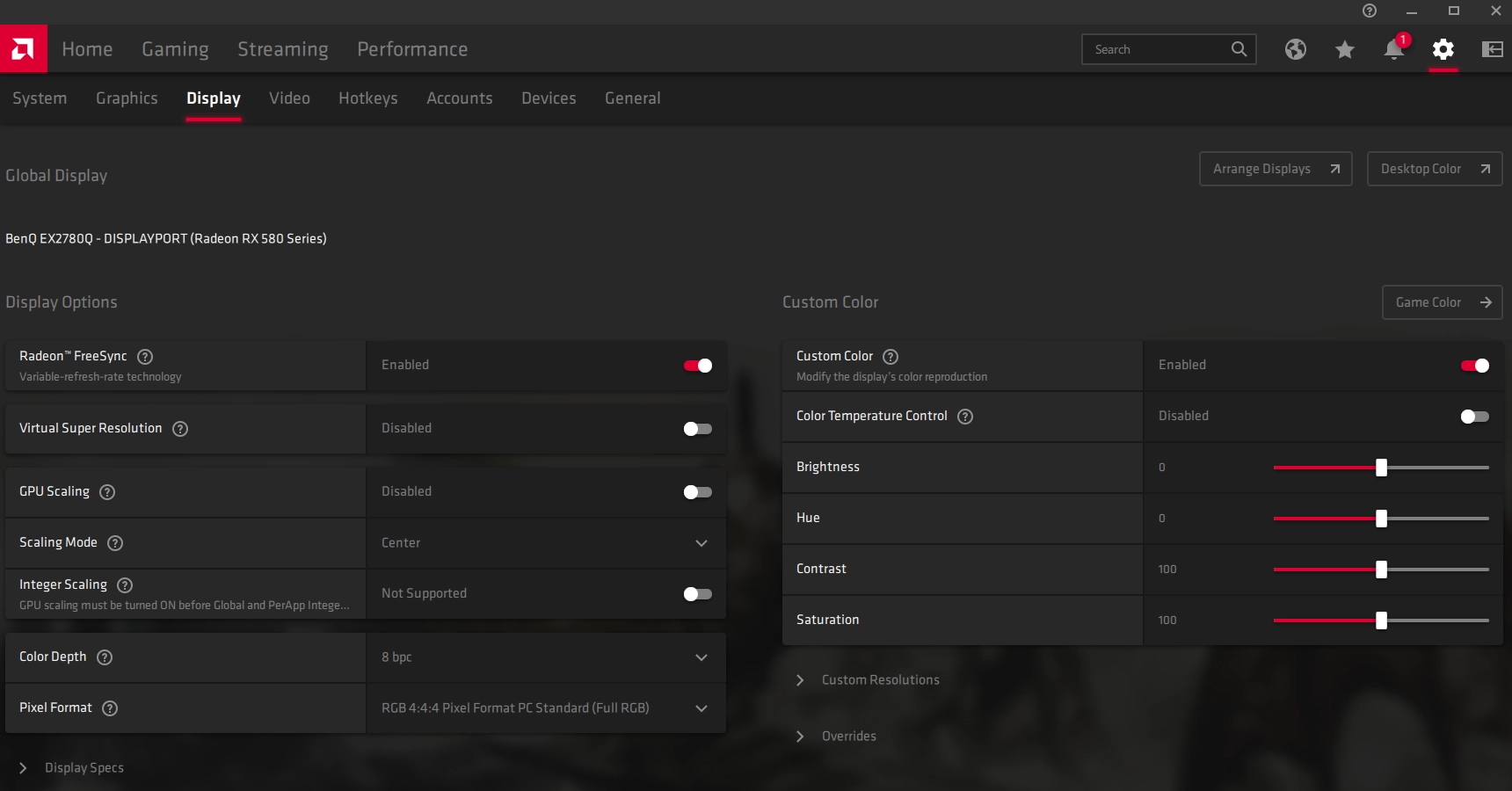
The BenQ supports a variable refresh rate range of 48 – 144Hz. That means that if the game is running between 48fps and 144fps, the monitor will adjust its refresh rate to match. When the frame rate rises above 144fps, the monitor will stay at 144Hz and the GPU will respect your selection of ‘VSync on’ or ‘VSync off’ in the graphics driver. With ‘VSync on’ the frame rate will not be allowed to rise above 144fps, at which point VSync activates and imposes the usual associated latency penalty. With ‘VSync off’ the frame rate is free to climb as high as the GPU will output (potentially >144fps). AMD LFC (Low Framerate Compensation) is also supported by this model, which means that the refresh rate will stick to multiples of the frame rate where it falls below the 48Hz (48fps) floor of operation for FreeSync. The variable refresh rate range and LFC support mean this model is AMD FreeSync Premium certified, specifically. If a game ran at 35fps, for example, the refresh rate would be 70Hz to help keep tearing and stuttering at bay. This feature is used regardless of VSync setting, so it’s only above the ceiling of operation where the VSync setting makes a difference.

Some users prefer to leave VSync enabled but use a frame rate limiter set a few frames below the maximum supported (e.g. 141fps) instead, avoiding any VSync latency penalty at frame rates near the ceiling of operation or tearing from frame rates rising above the refresh rate. If you go to ‘System’ – ‘Information’ in the OSD, you will see the refresh rate listed there alongside resolution for ‘Current Resolution’. The displayed refresh rate changes if Adaptive-Sync is active and reflects the frame rate at the time of entering that section of the OSD. Provided it’s within variable refresh rate range – it is after all a refresh rate rather than frame rate being displayed. Finally, it’s worth noting that FreeSync only removes stuttering or juddering related to mismatches between frame rate and refresh rate. It can’t compensate for other interruptions to smooth game play, for example network latency or insufficient system memory. Some game engines will also show stuttering (or ‘hitching’) for various other reasons which won’t be eliminated by the technology.
FreeSync – the experience
Nvidia Adaptive-Sync (‘G-SYNC Compatible’)
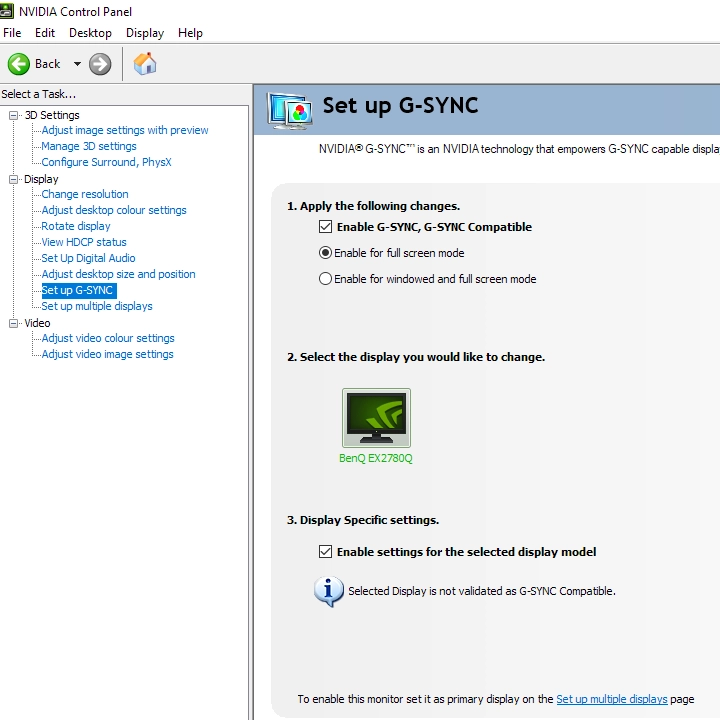
You will also see in the image above that it states: “Selected Display is not validated as G-SYNC Compatible.” This means Nvidia hasn’t specifically tested and validated the display, not that it doesn’t work. Indeed the technology did work in much the same was as FreeSync, removing tearing and stuttering from frame and refresh rate mismatches and allowing HDR to be used at the same time if desired. Our earlier observations should therefore be referenced for what to expect. A slight difference was that the floor of operation was 55Hz rather than 48Hz. Below this, an LFC-like behaviour was observed which ensured refresh rate was kept at a multiple of frame rate.
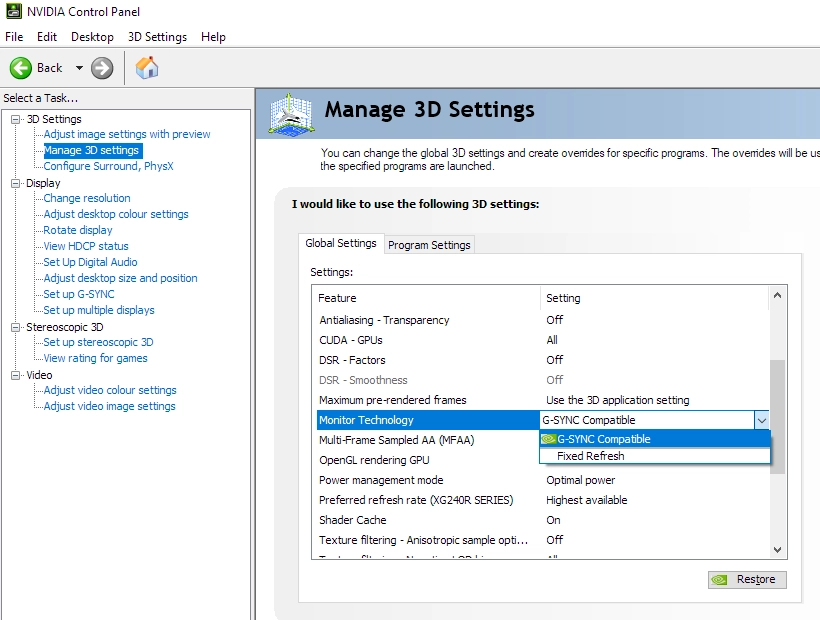
Finally, note again that you can go to ‘System’ – ‘Information’ in the OSD to see if the technology is working. If it is, the refresh rate displayed will reflect the frame rate of the content, if it’s within the variable refresh rate range of the display. It is updated when you enter that section of the OSD rather than in real time.
HDR (High Dynamic Range)
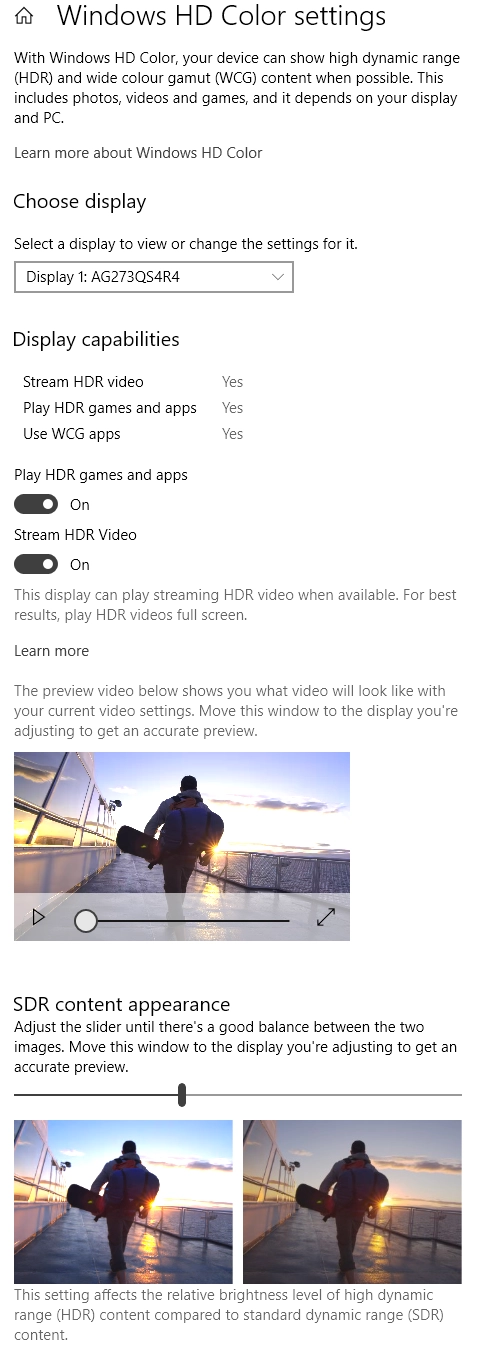

Colour gamut 'Test Settings' Nvidia GPU

Colour gamut 'Test Settings' AMD GPU
The monitor supports 10-bits per channel colour output, as required for HDR10 content. This is achieved with a dithering stage on the monitor at 120Hz or 60Hz (8-bit + FRC), whereas at 144Hz the dithering stage is offloaded to the GPU. We’ve carefully observed a range of content on various monitors where a 10-bit signal is supported by the monitor and where it’s partially offloaded to the GPU. Including this model, where the method used depends on the refresh rate selected. Even when observing fine gradients such as weather effects and areas of smoke and sky, the end result is very similar whether the monitor or GPU is handling the dithering stage. A careful side by side comparison or observing certain content may reveal subtle differences, but we don’t see the GPU dithering stage as a reason to avoid using 144Hz on this monitor. Regardless of how it’s achieved, the enhanced precision provided an improved nuanced shade variety compared to under SDR. The look here was much more natural than a gamma enhancement feature that could be applied under SDR, with a good variety of closely matching dark shades. Considering brighter shades, the enhanced precision allowed for much smoother gradients and a better nuanced variety to be displayed there as well. Enhancing the look of weather effects, smoke and suchlike. The image below is taken from one of our favourite scenes for testing HDR, on Shadow of the Tomb Raider. The photo is purely for illustrative purposes and in no way represents how the monitor appeared running HDR first hand.

Interpolation and upscaling

Video review
Timestamps:
Features & Aesthetics
Contrast
Colour reproduction
HDR (High Dynamic Range)
Responsiveness
Conclusion
Positives Negatives Good out of the box gamma tracking and a generous colour gamut – vibrant and varied colour reproduction HDR capability quite limited, although better than some implementations at this ‘level’ Reasonable static contrast, largely as expected for the panel type. Plus a light matte screen surface that keeps the image free from obvious graininess Moderate ‘IPS glow’ ate away at detail and atmosphere in dark scenes Low input lag and a competent 144Hz performance overall. Adaptive-Sync worked well on both our AMD and Nvidia GPUs to remove tearing and stuttering from frame and refresh rate mismatches Some weaknesses in pixel responsiveness adding a little ‘powdery trailing’ and overshoot in places. Optimal response time setting depends on refresh rate (no variable overdrive) A nice resolution for work and play, a surprisingly handy IR remote, integrated subwoofer and unique styling Limited ergonomic flexibility, priced a bit high in some regions
As an Amazon Associate I earn from qualifying purchases made using the below link. Where possible, you’ll be redirected to your nearest store. Further information on supporting our work.



